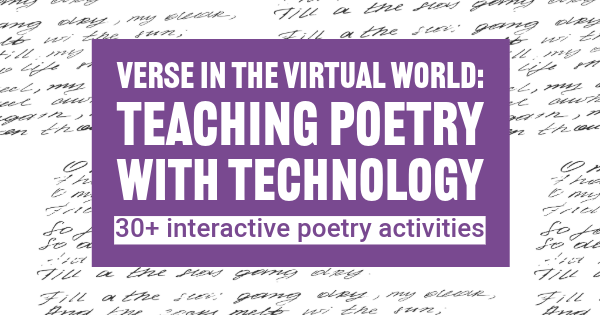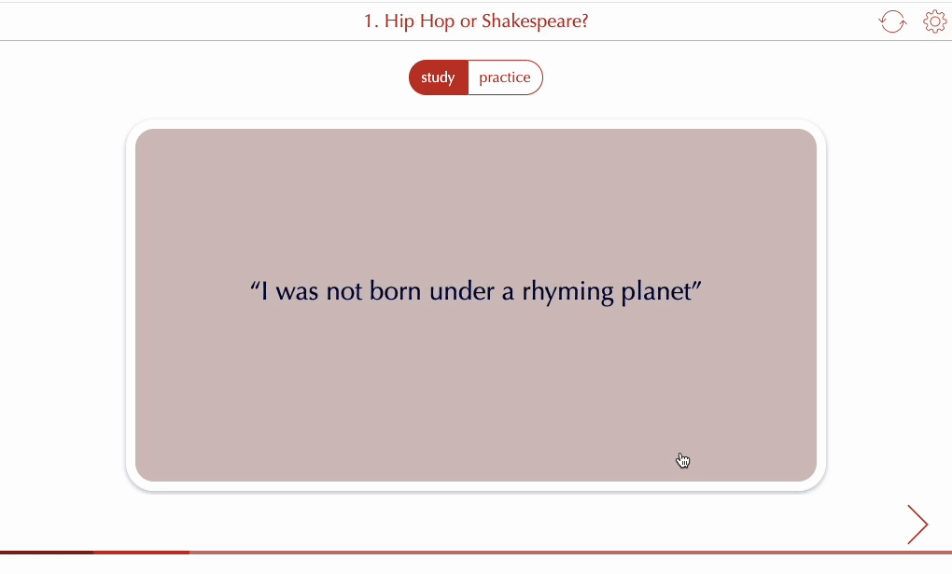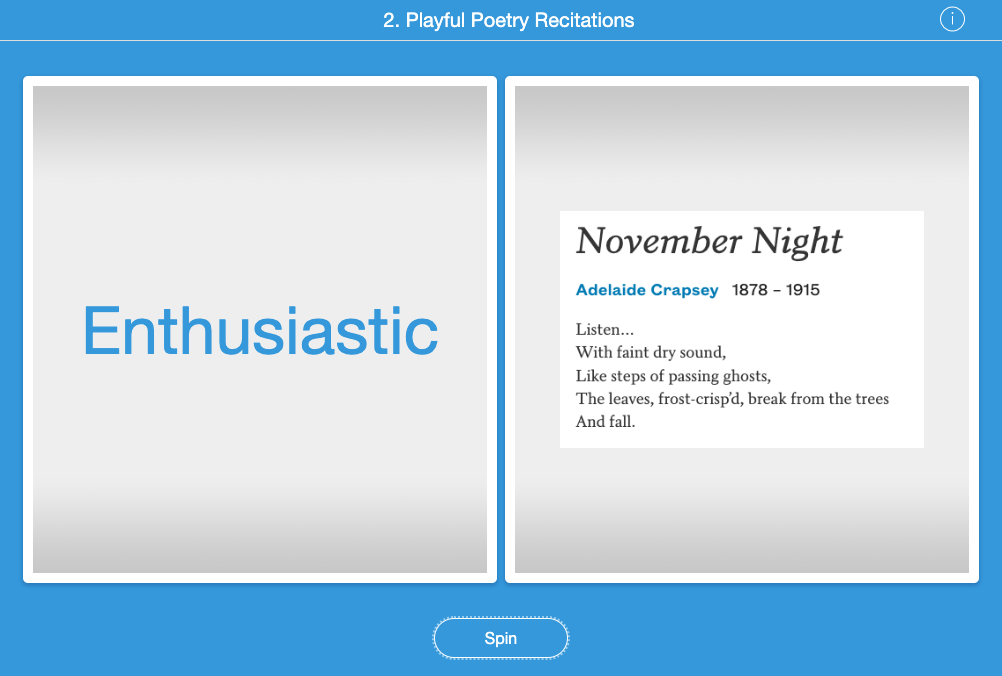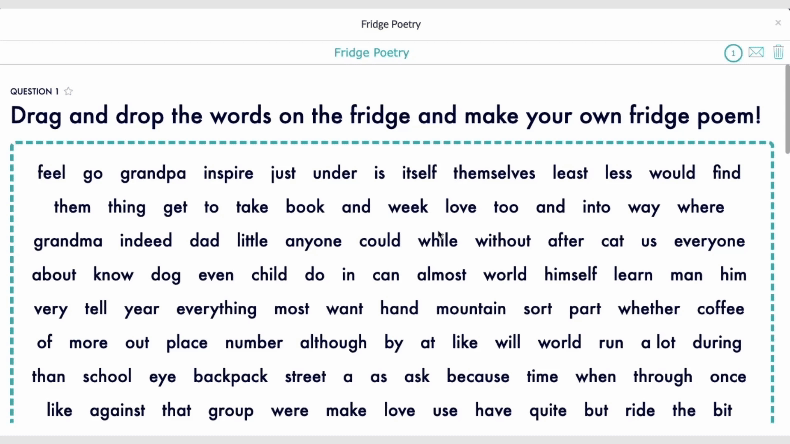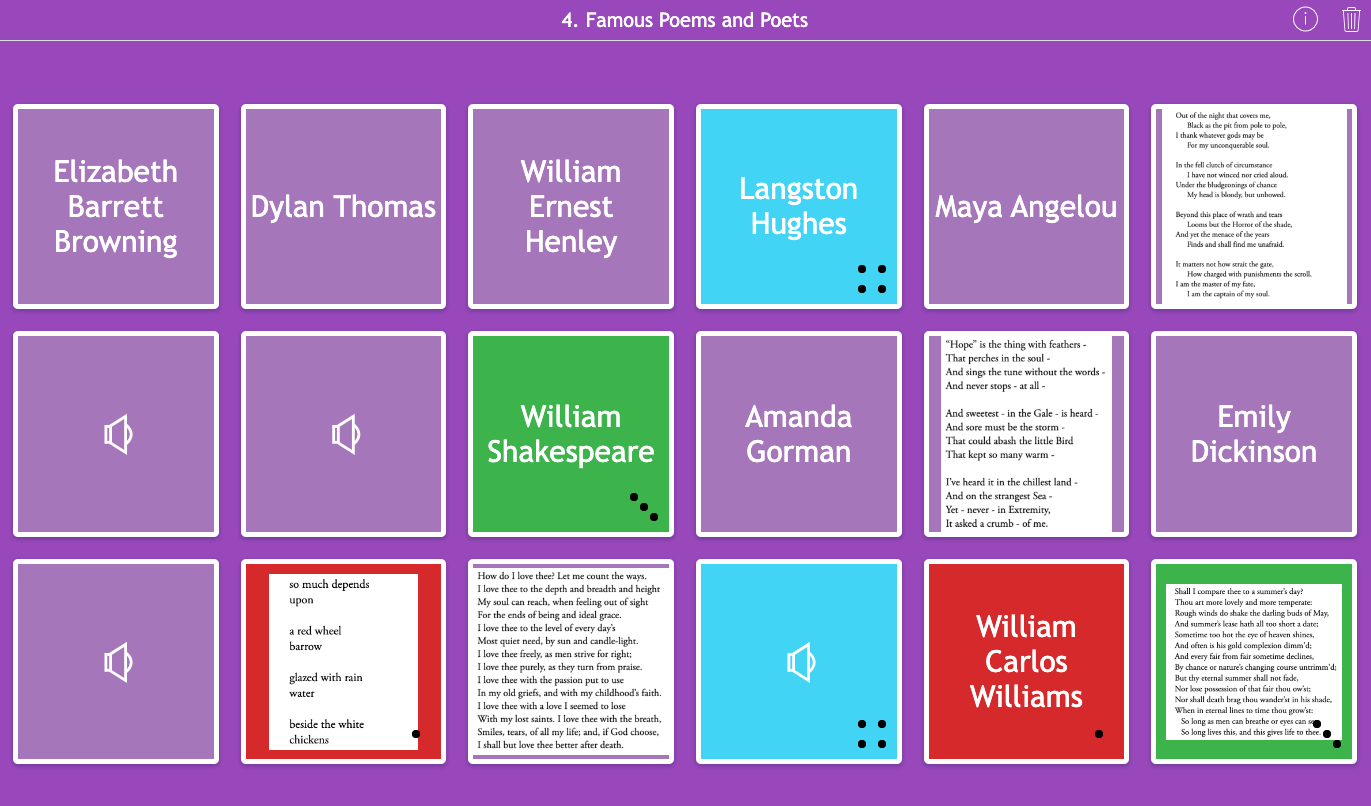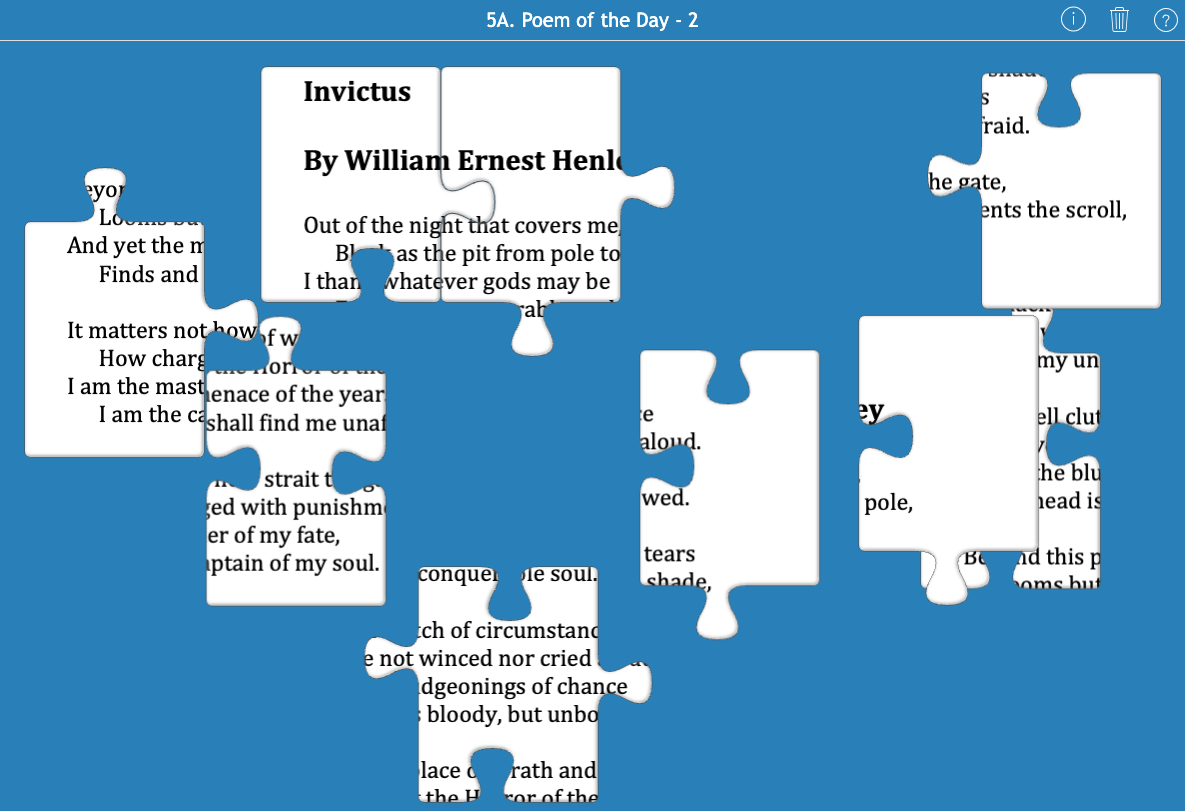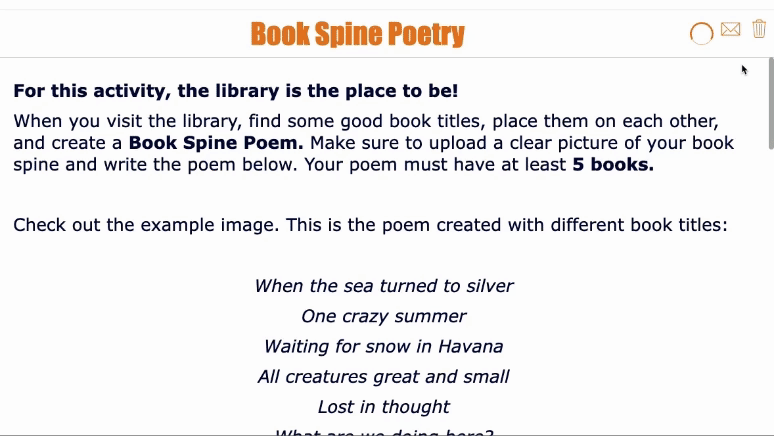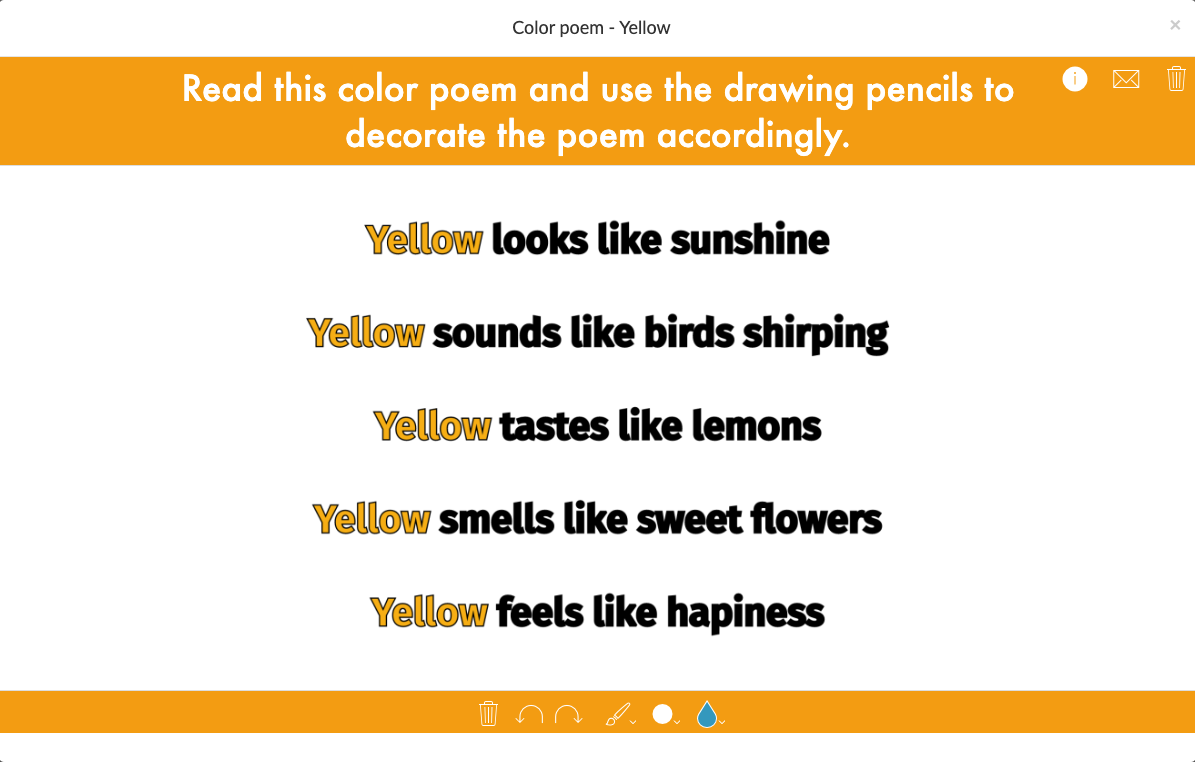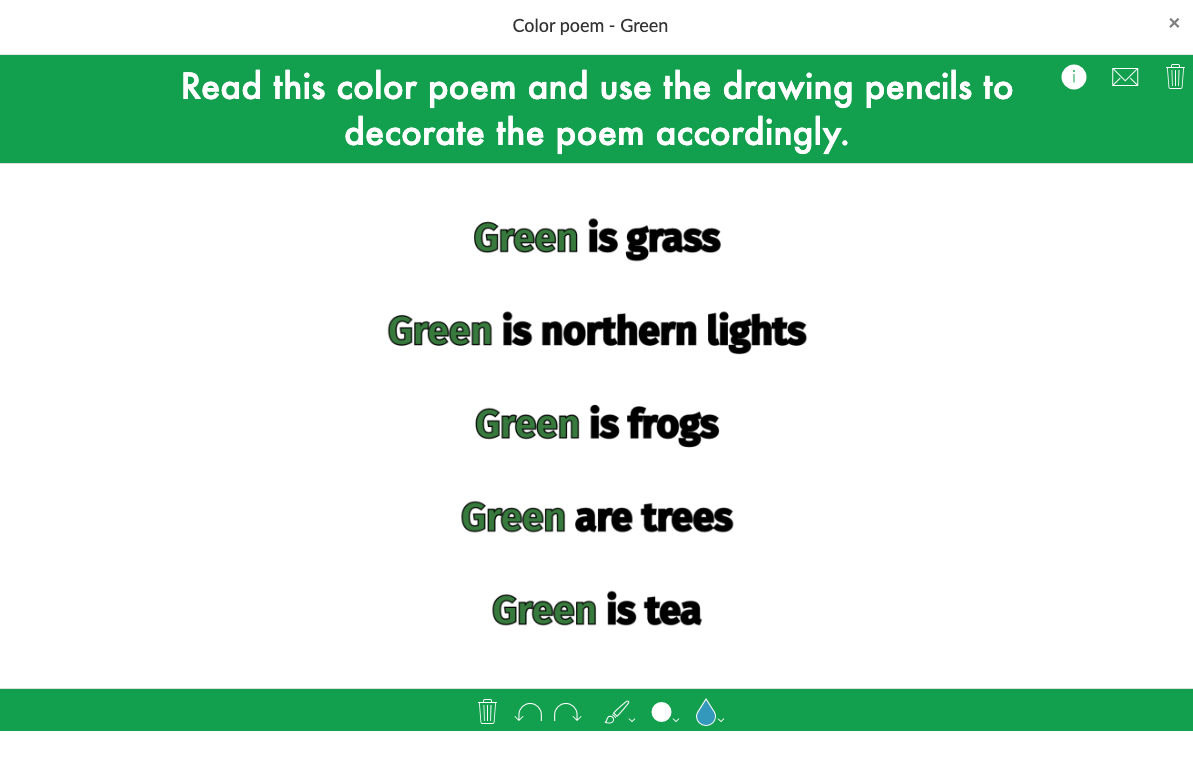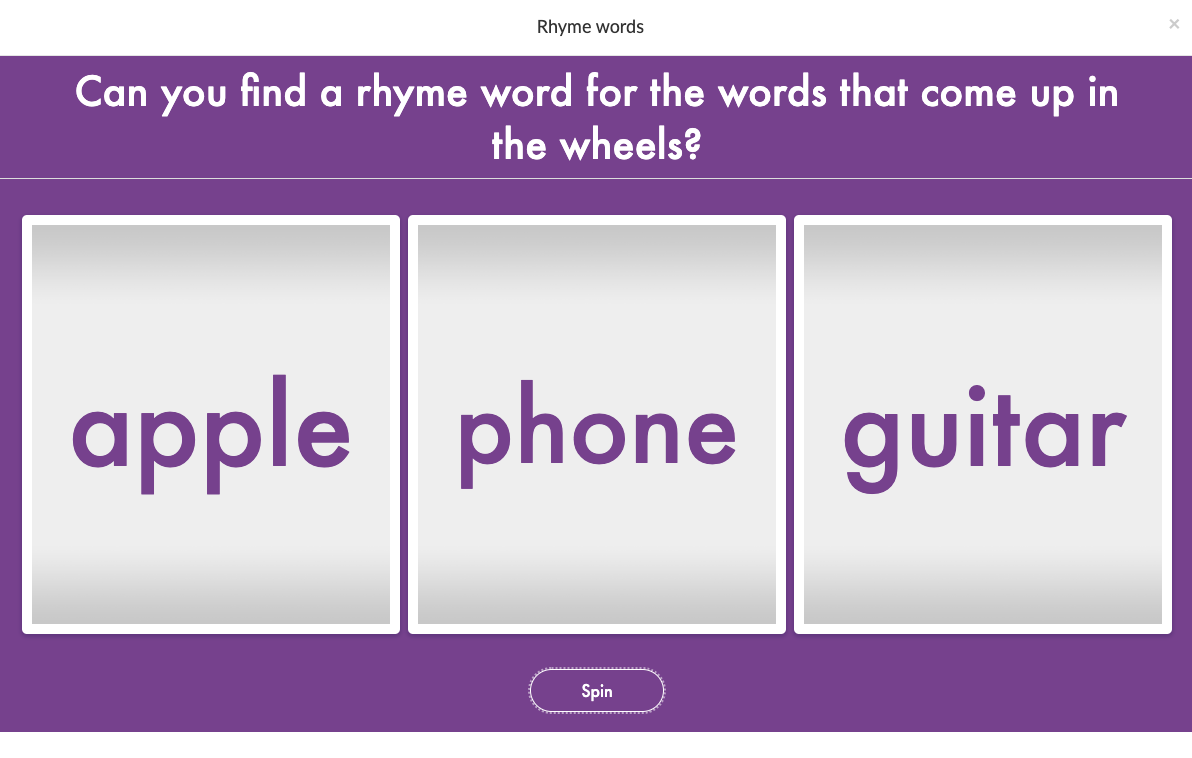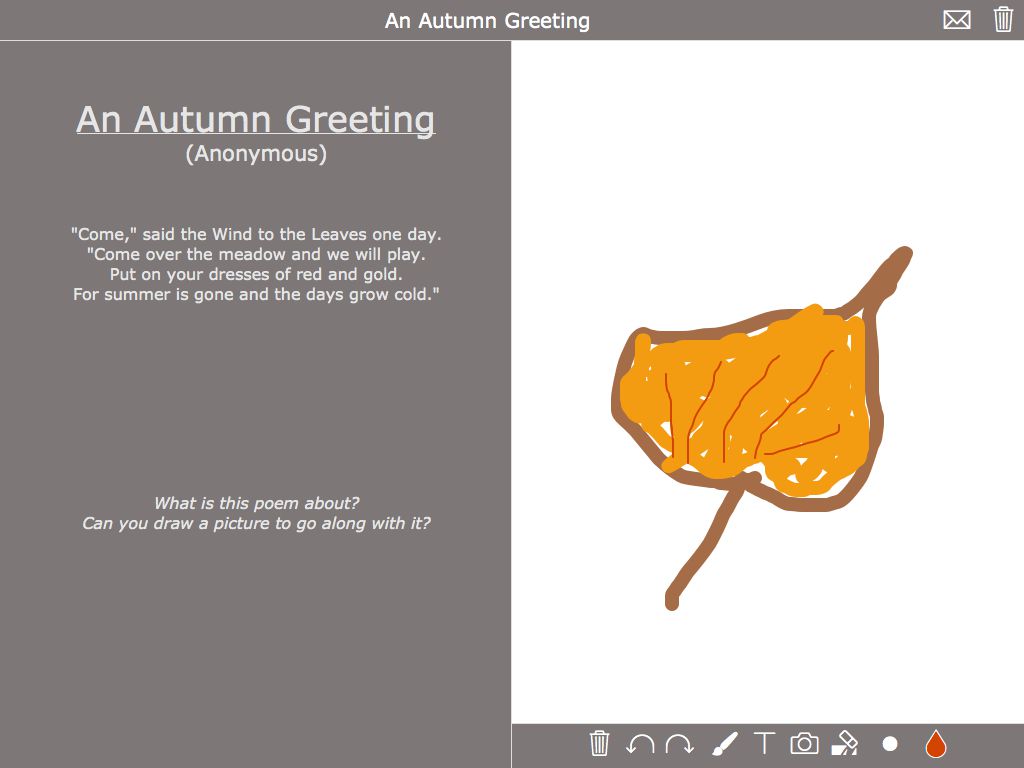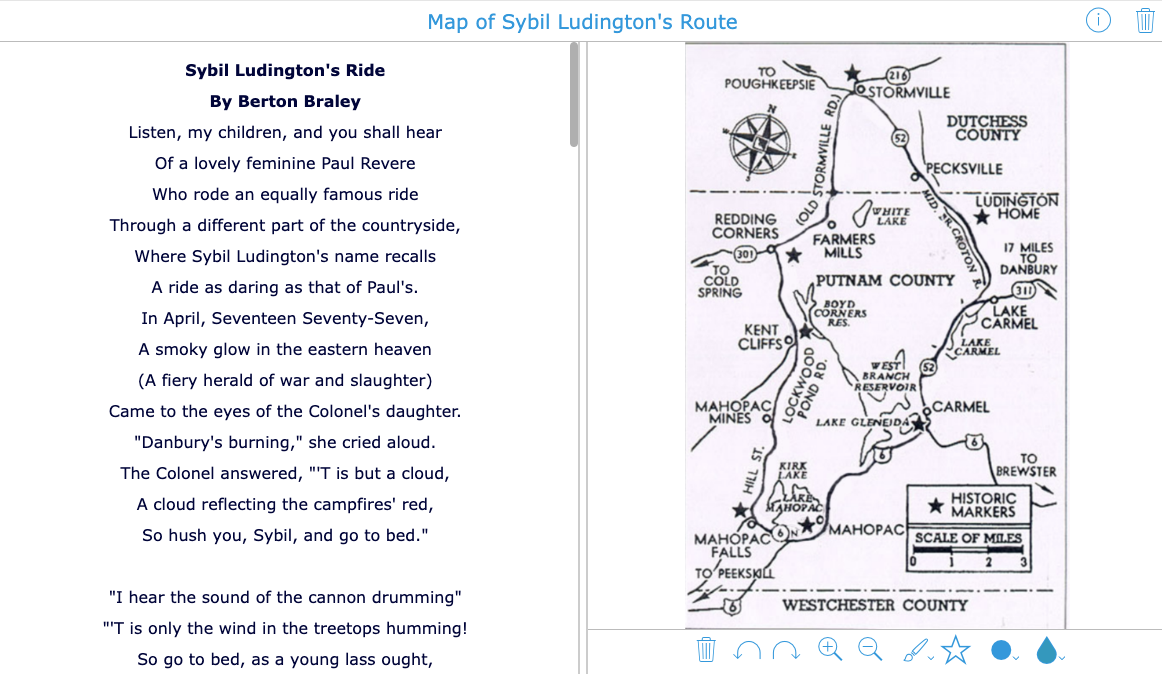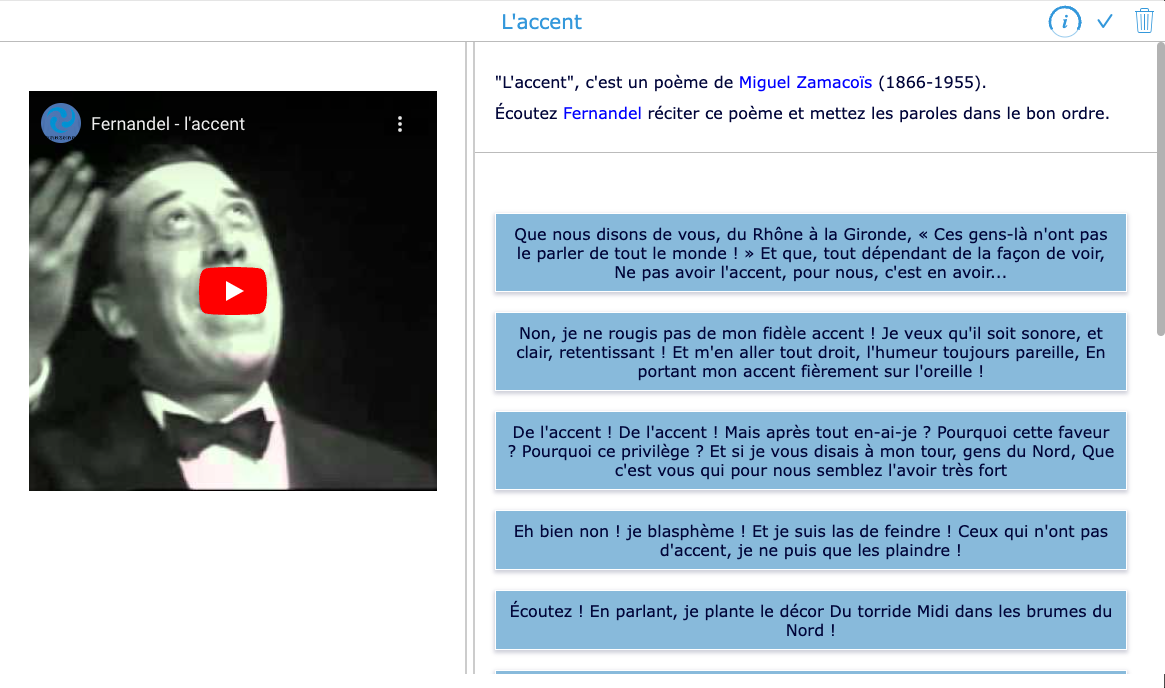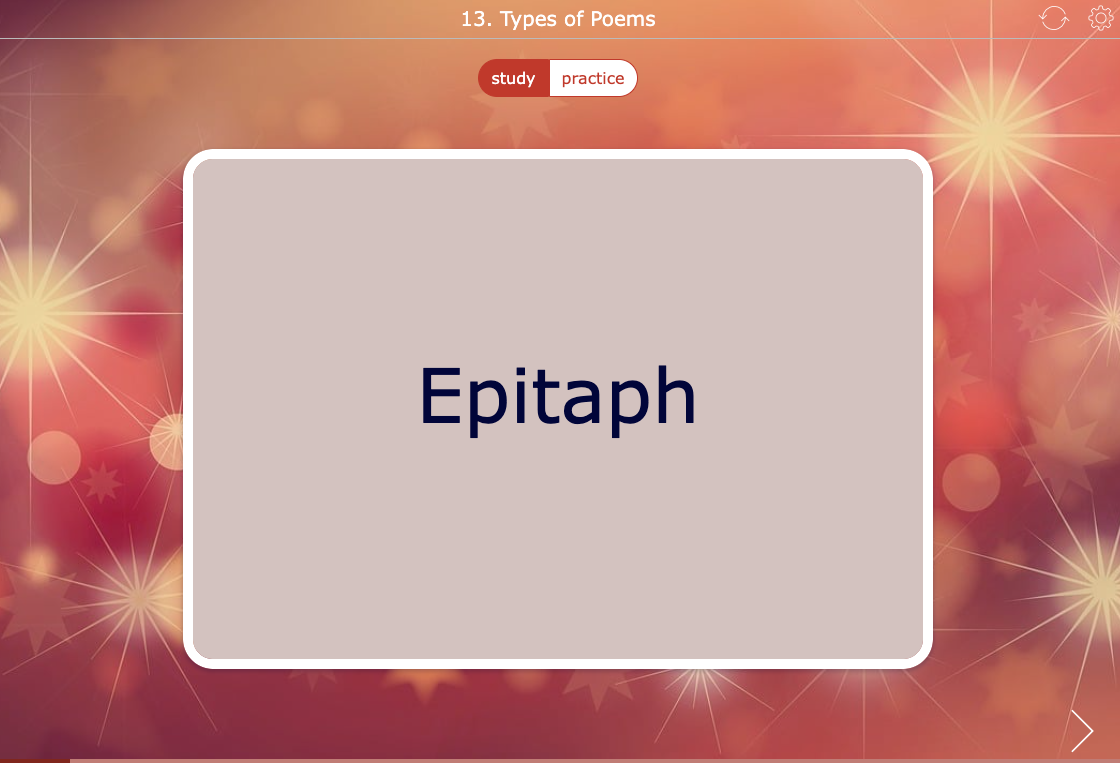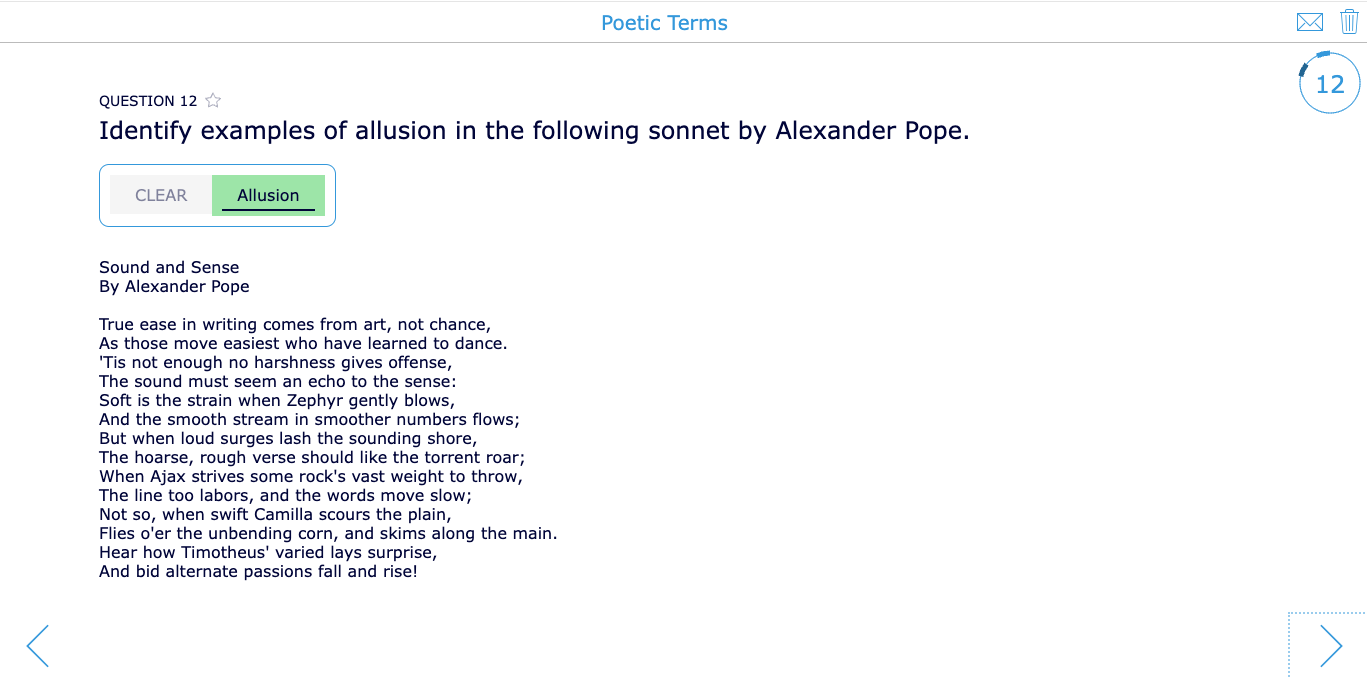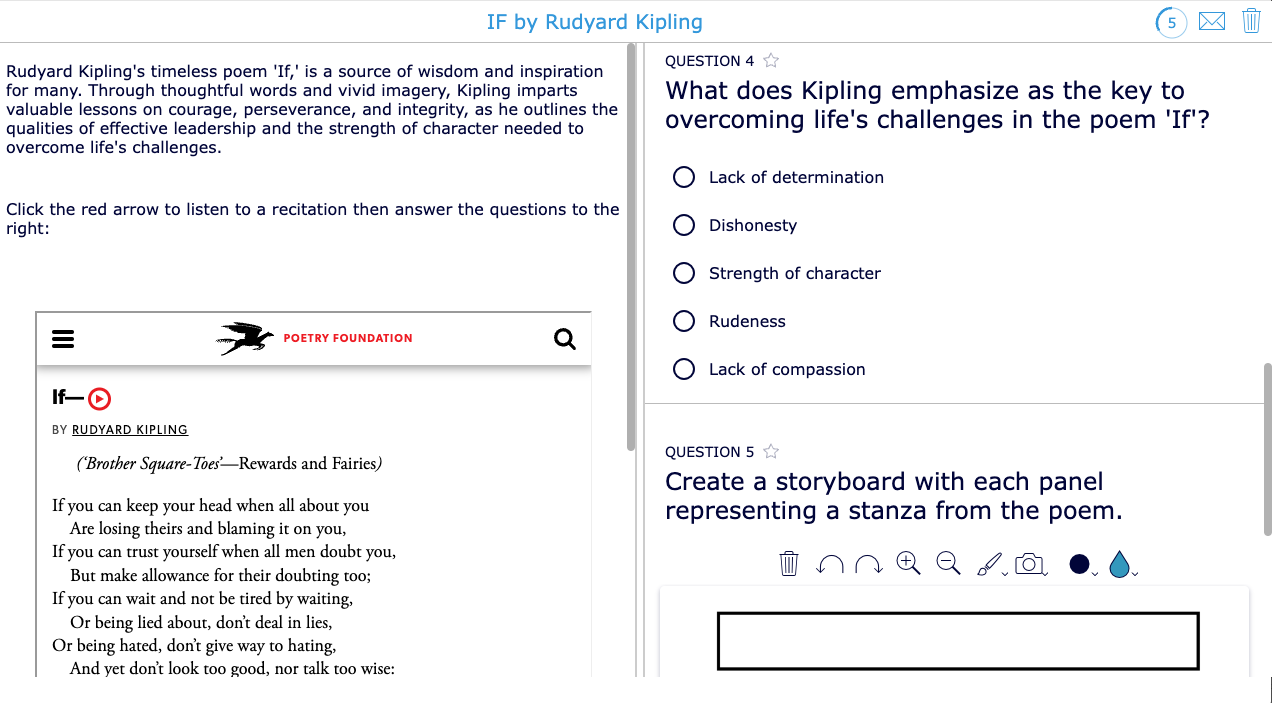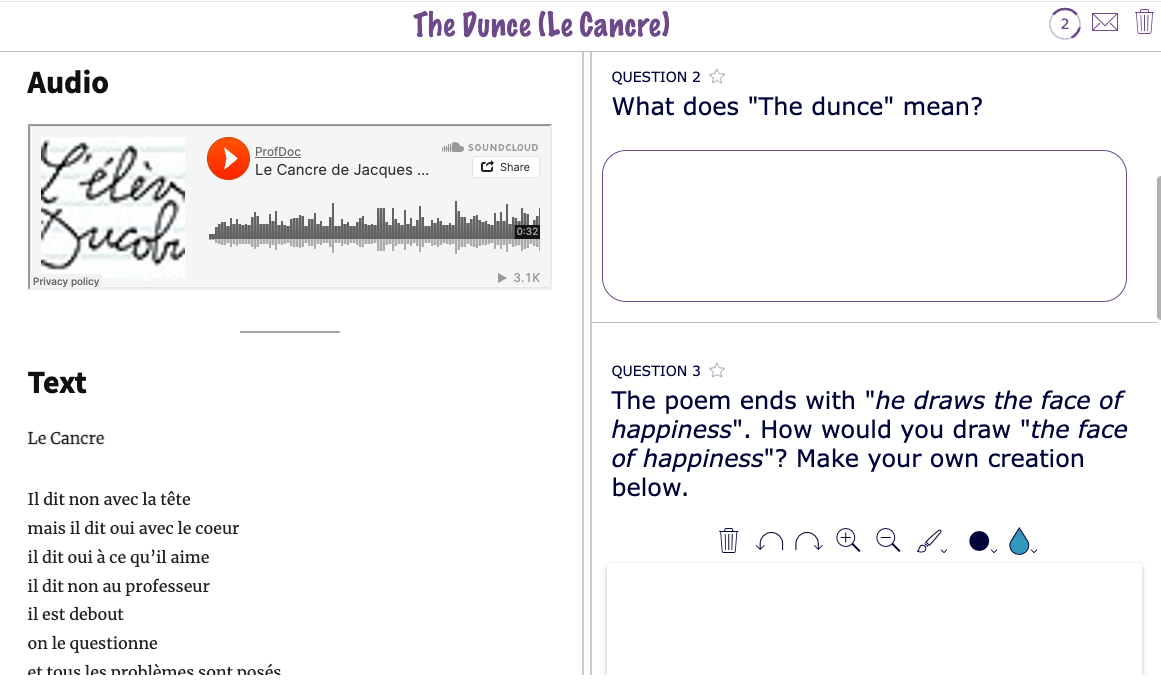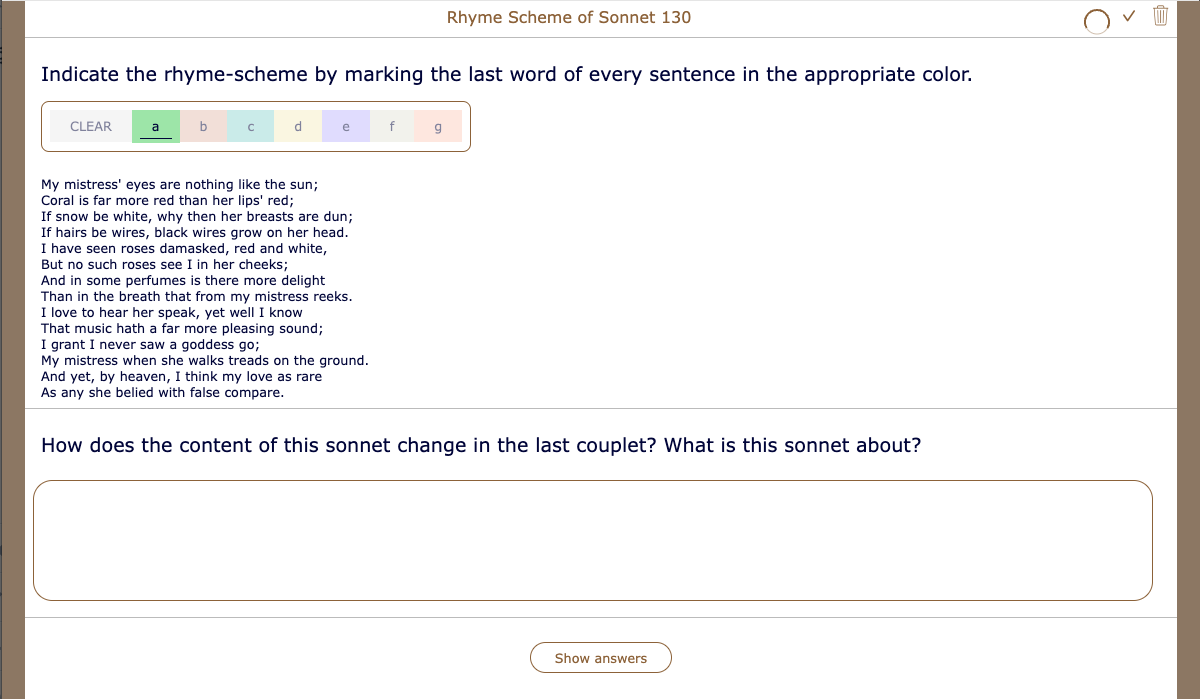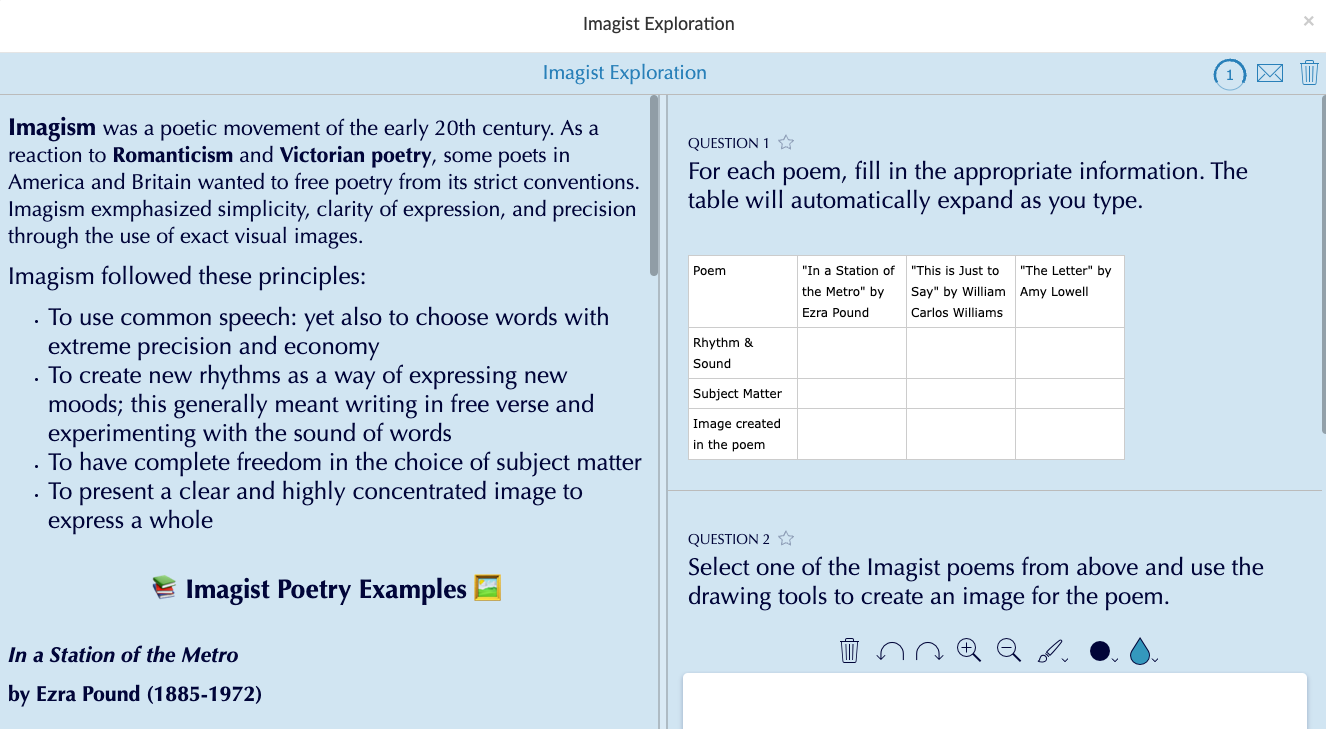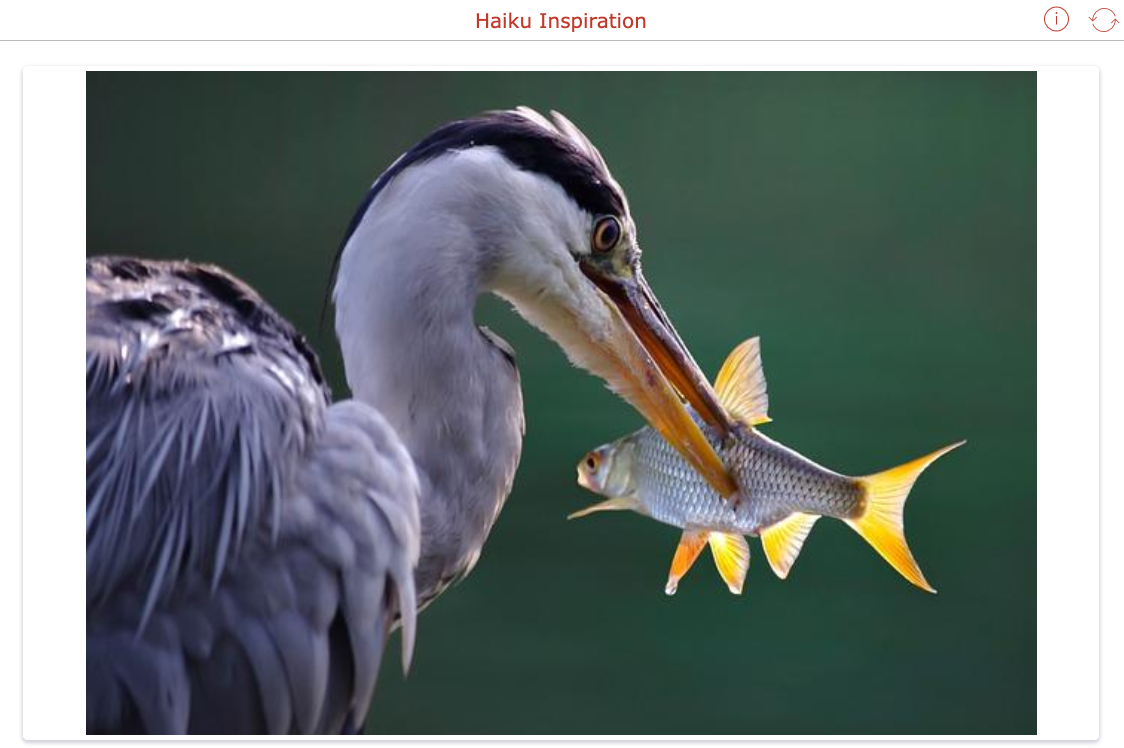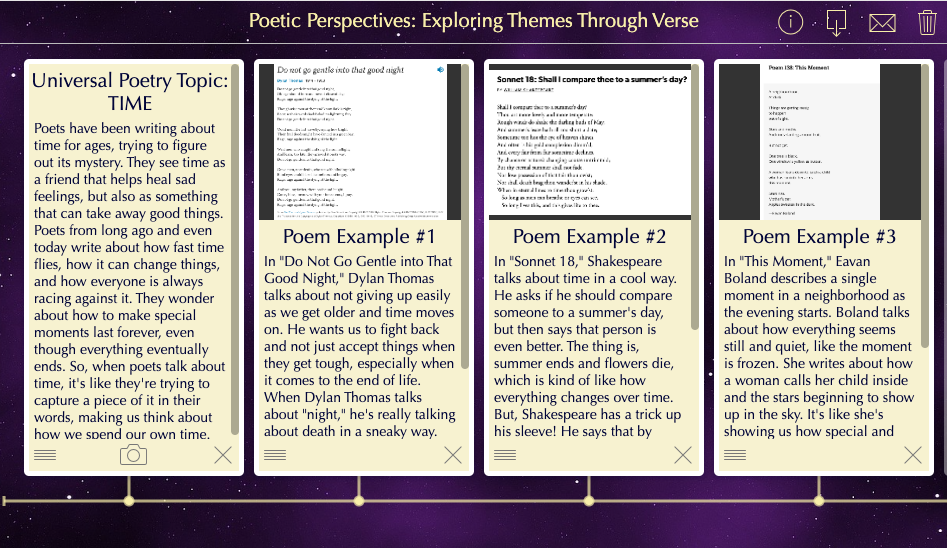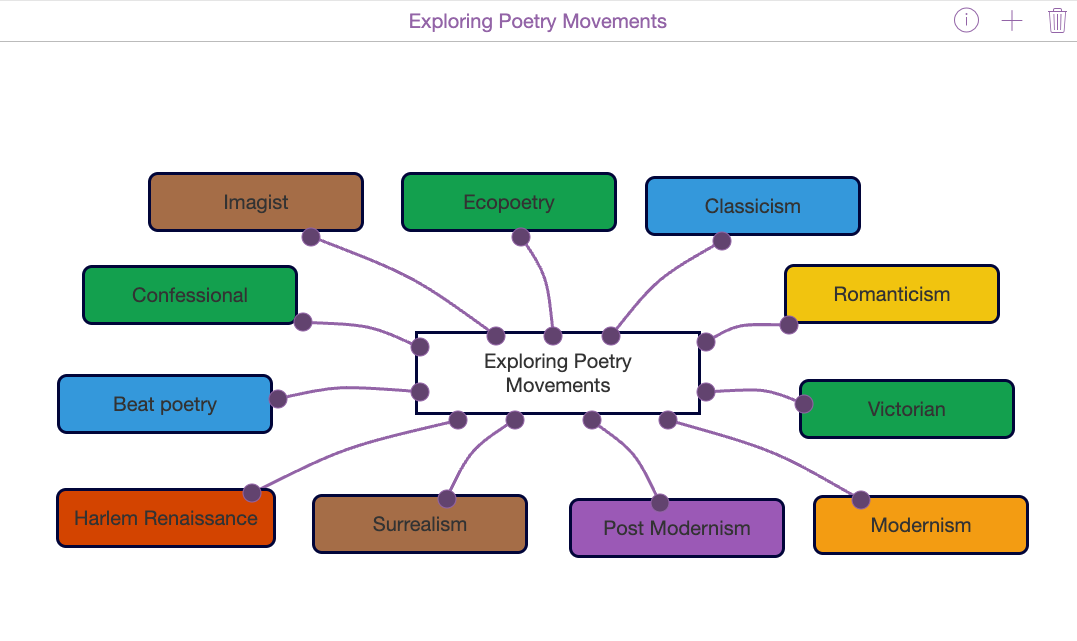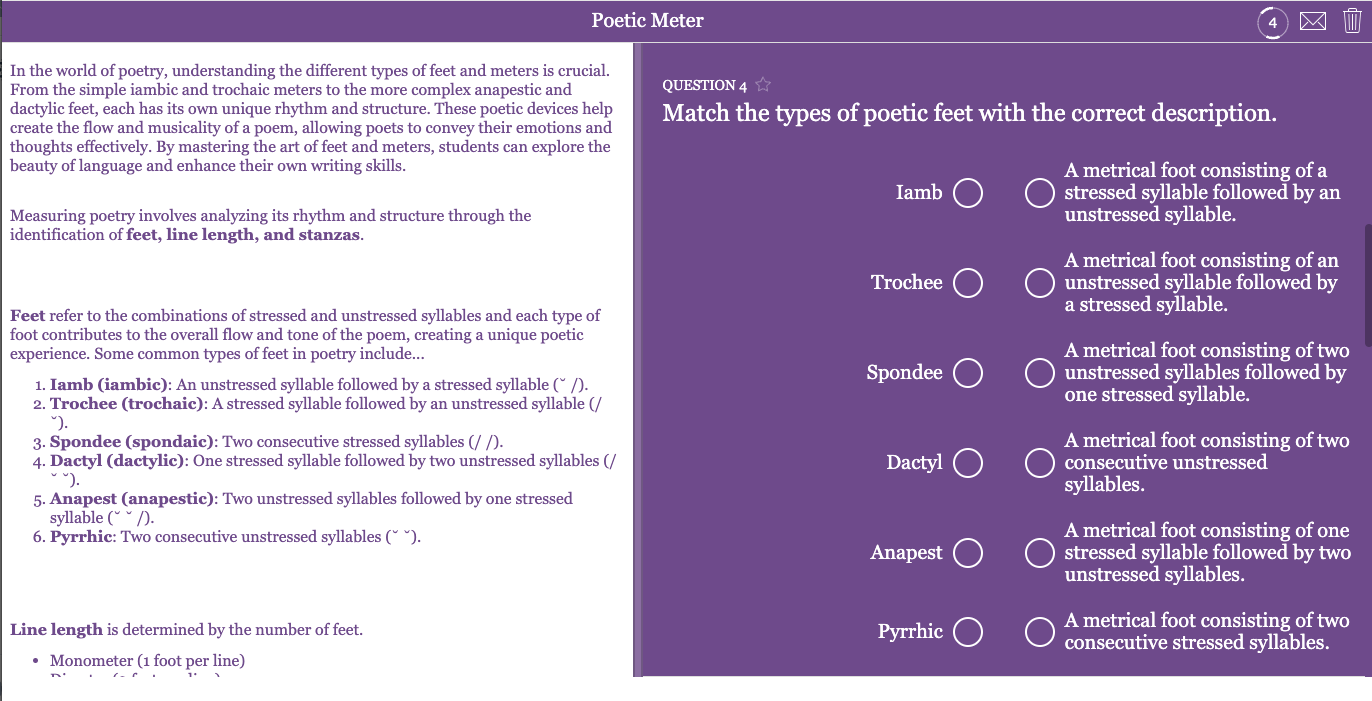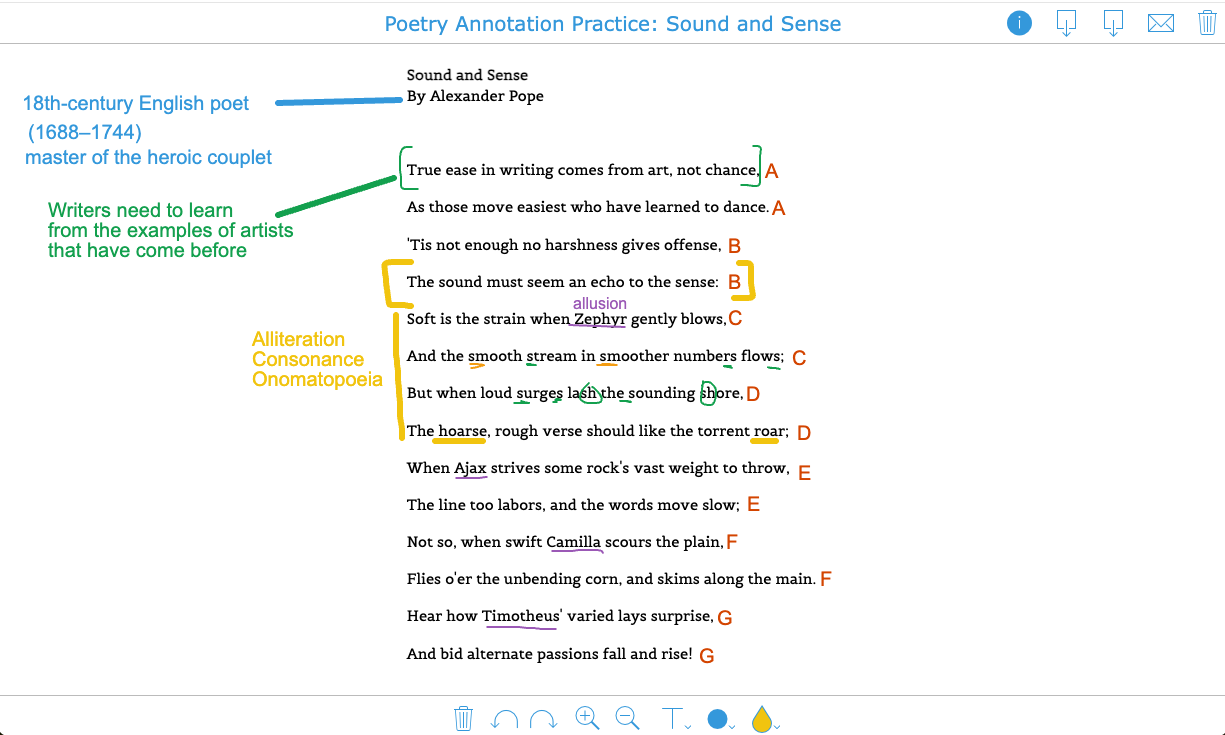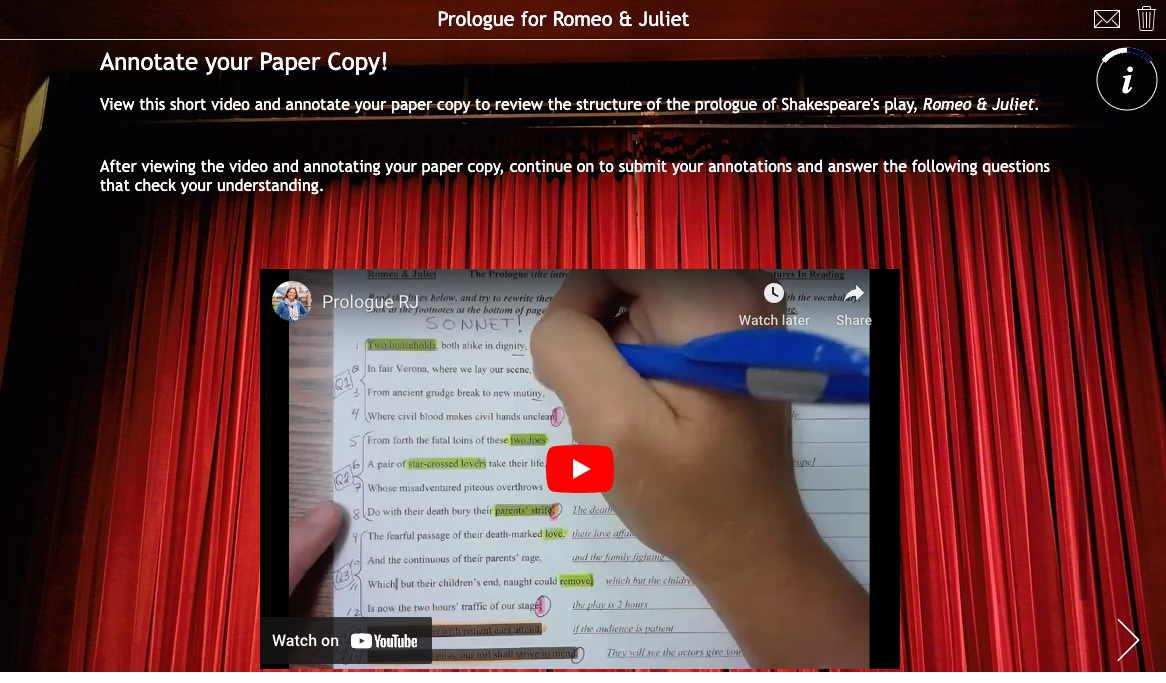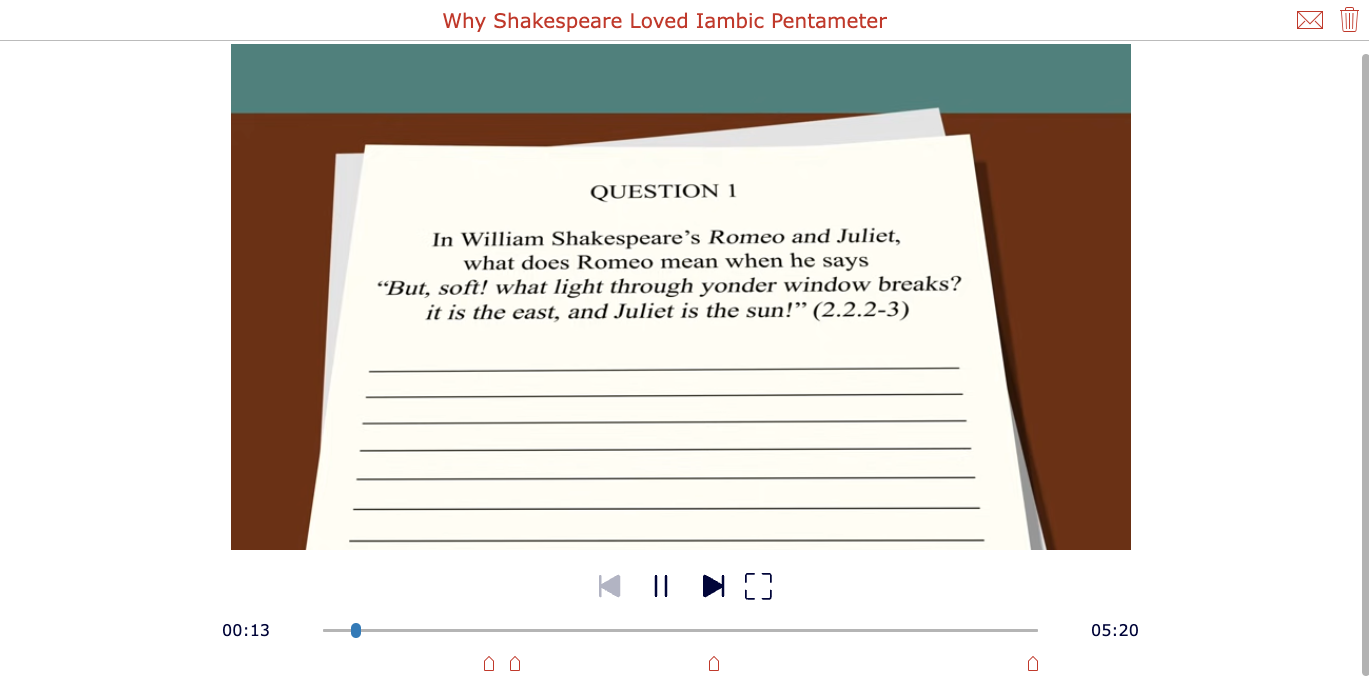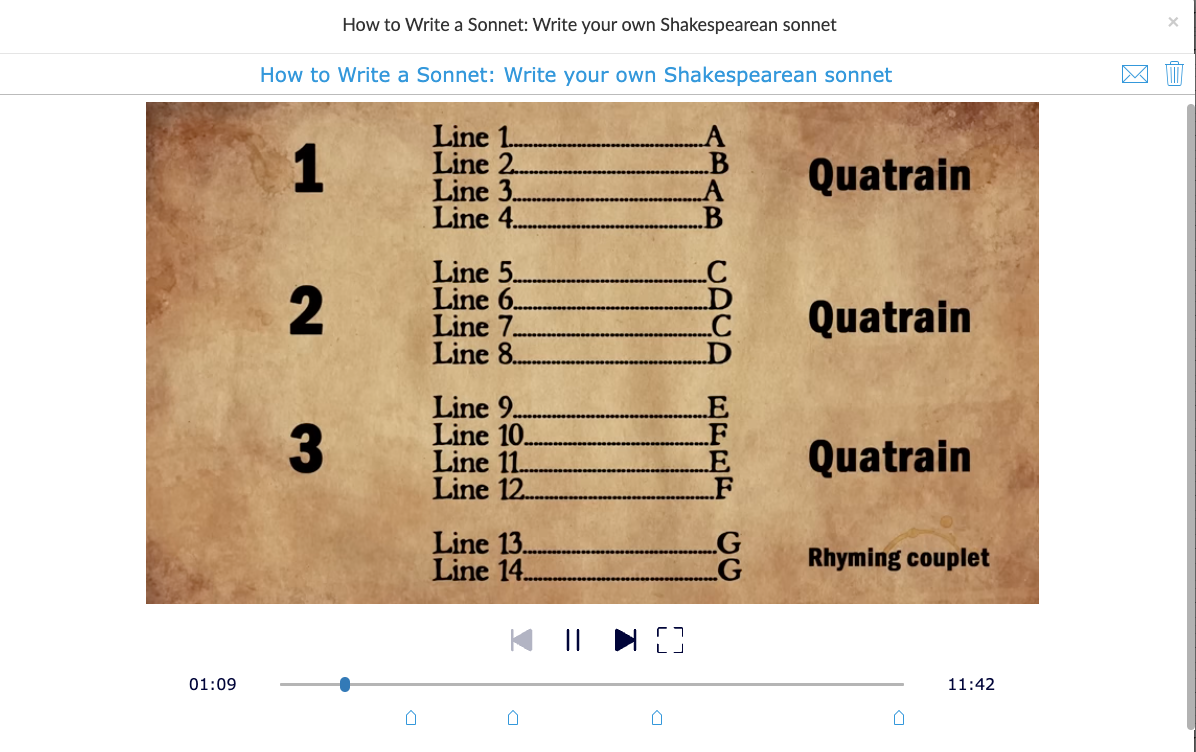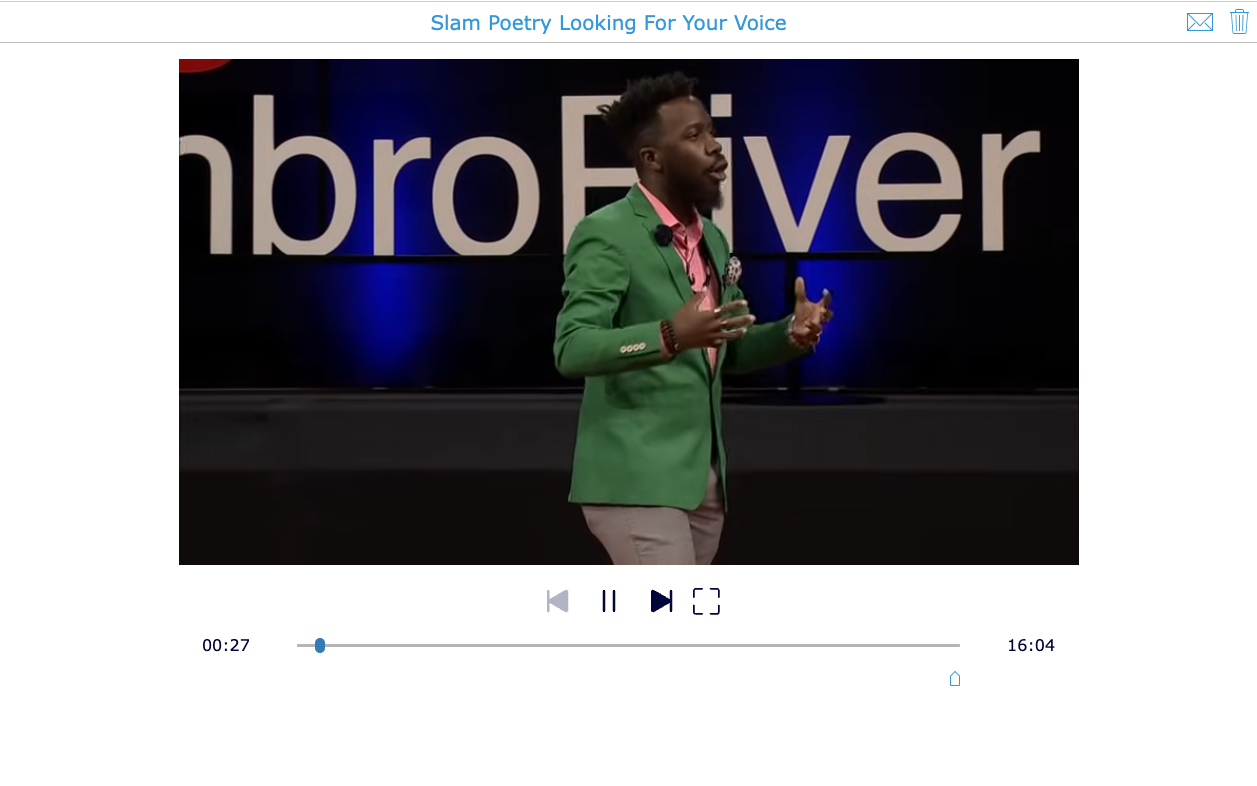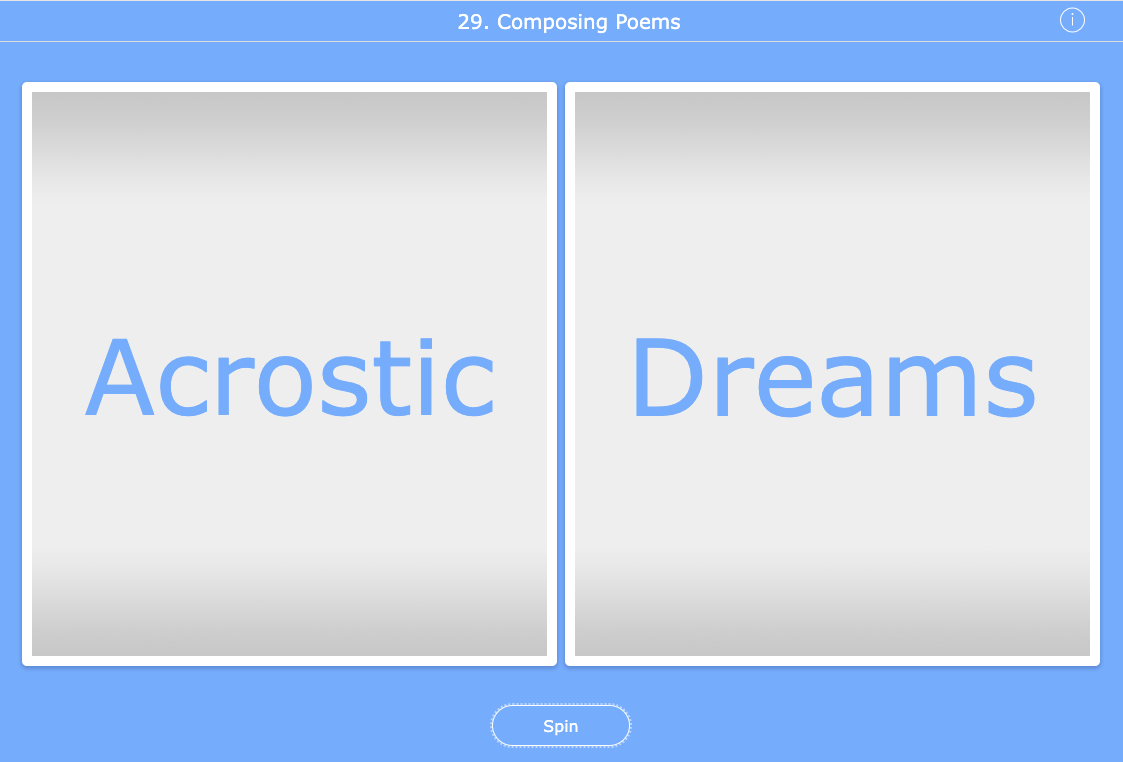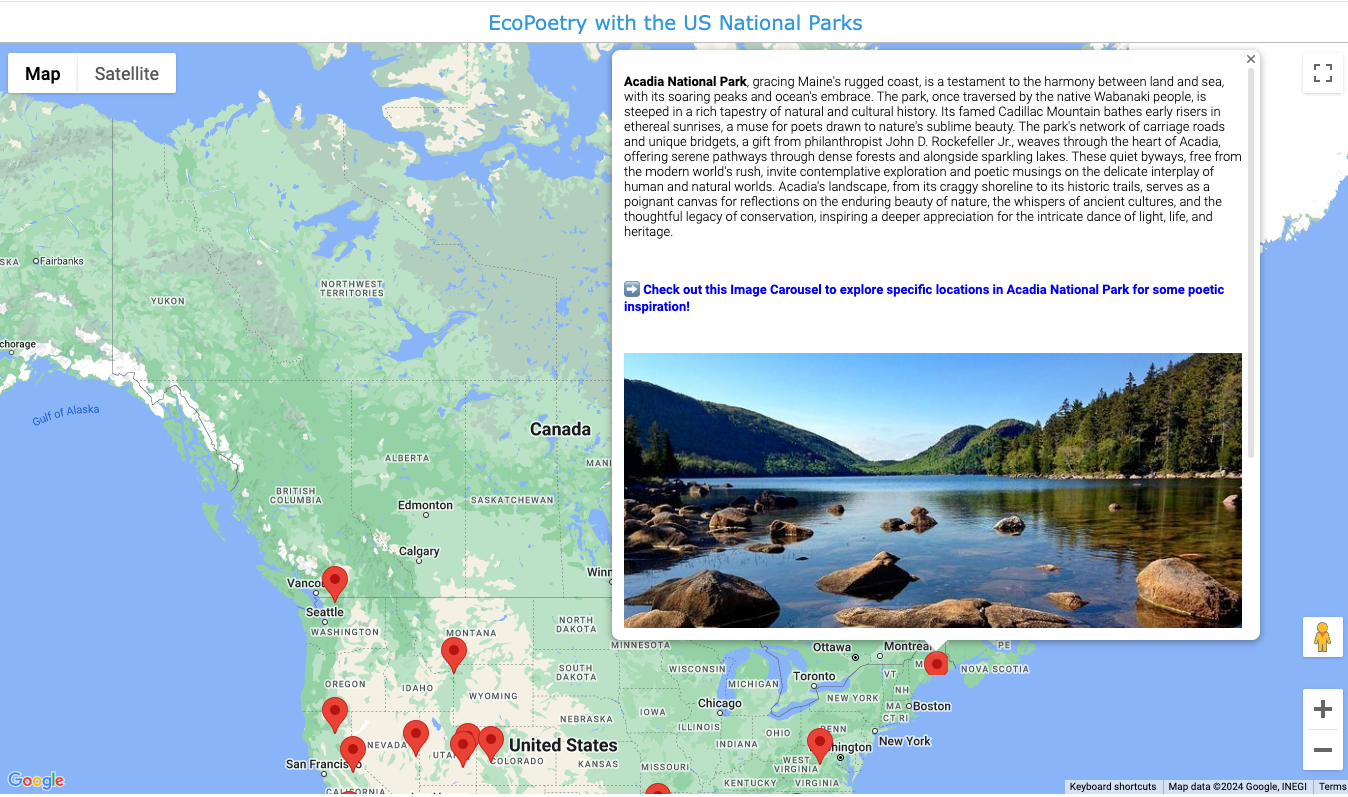Verse in the Virtual World: 30+ creative poetry classroom activities
 Kate Baker —
Kate Baker —
Looking for free digital poetry lessons for middle and high school students? This curated collection of 30+ interactive poetry activities using BookWidgets is ideal for teaching poetry with technology during National Poetry Month, International Haiku Poetry Day, and William Shakespeare’s birthday—or any time of year. Whether you’re looking for game-based poetry learning, multimedia poetry annotation tools, or want to try ecopoetry activities for the classroom, these engaging poetry lesson plans will help make poetry fun, accessible, and meaningful for every student.
From interactive classroom games that bring the timeless verses of Shakespeare and other poets to life, to creative tools that guide students in crafting their own poetic masterpieces, I’ve grouped these engaging classroom poetry activities into three sections for teaching poetry in the classroom:
🔗 Jump to a Section
🎮 Game-Based Poetry Activities for Student Engagement
Explore interactive poetry games and digital poetry warm-ups that make learning fun.✍️ Teach Poetic Devices with Interactive Lessons
Introduce poetic forms, structure, rhyme schemes, and figurative language with creative tech tools.🌟 Advanced Poetry Lessons for Creative Expression
Inspire student voice and mastery with slam poetry, annotation activities, and sonnet composition.
💡 Before we begin: If you are new to BookWidgets, BookWidgets is a content creation and evaluation tool for teachers. We provide the tools to support your students’ learning process from beginning to end with customizable templates (aka widgets) for creating activities and a reporting dashboard to track your students’ progress. I have a digital poetry activity for many of our 40 widget types. You can create your own or duplicate the ones I share by opening the activity and making a copy in your account. After duplicating, you can make changes to the activity, customizing it for your students. By clicking on this link you can access all the digital poetry activities mentioned in this blog post.
💡 Keep in mind: If you integrate BookWidgets into a Learning Management System like Google Classroom, Microsoft Teams, Moodle, Canvas –& more!–, you can use “Live Widgets” to keep an eye on your students’ progress in real time to give feedback and support when needed.

Game-Based Poetry Activities for Student Engagement
In this first set of online poetry games for the classroom, we blend poetry with game-based learning strategies to spark student curiosity and engagement in a fun and interactive way. These interactive poetry activities for middle school and high school students include guessing whether a poetic line is from Shakespeare or a Hip Hop artist, spinning a wheel to choose a recitation style, matching poets to their works, and solving jigsaw puzzles that reveal poems. These digital poetry activities make poetry more accessible and enjoyable while helping students build confidence and enthusiasm for exploring poetic language and structure.
1. Guess the Poet: Hip Hop Lyrics or Shakespeare Lines?
Why Hip Hop? The lyrics in Hip Hop often follow poetic structures, utilizing techniques such as rhyme, alliteration, assonance, and metaphor to create impactful narratives and imagery. Like poetry, Hip Hop gives voice to personal and societal experiences, exploring themes of identity, struggle, social justice, love, and community. Hip Hop also brings the rhythm and beat of poetry to life through performance: the dynamic interaction between performer and audience in Hip Hop mirrors the recitation of poetry, where the delivery, tone, and pace are crucial to the interpretation and impact of the words (which will serve as a great introduction to poetic meter in our later poetry interactive lessons!).
This first virtual activity connects contemporary lyrics to Shakespeare by having students use this Flash Card widget to guess whether a line of poetry was written by William Shakespeare or various Hip Hop artists such as Tupac, Blackalicious, or Eminem. Can you accurately guess the author of each line? 👇
💡 Pro tip: You can easily transform a Flash Card widget into another widget-type using the import feature. Here I imported the Flash Cards from above to create this Pair Matching activity. Can you accurately match the author with the line?
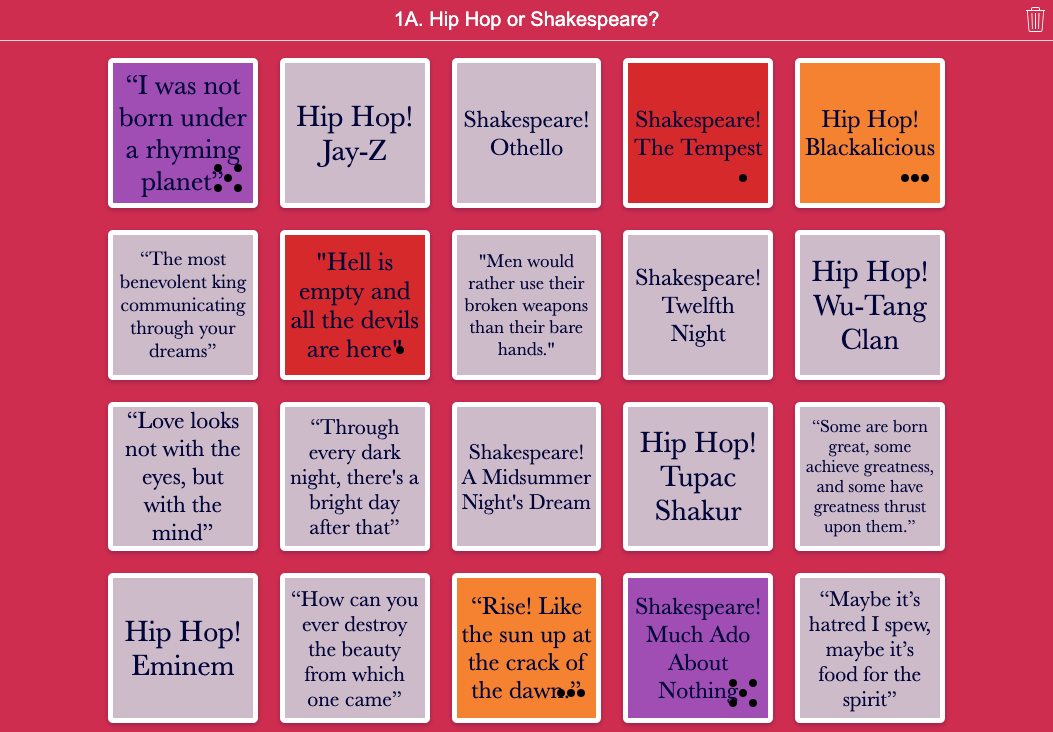
Click to open
2. Spin-the-Wheel Poetry Recitation Game
In this activity, made with a Randomness widget, students take turns spinning two wheels: one to select a poem and the other to choose an emotion or style for their recitation. This playful approach not only breaks the ice, but also encourages students to experiment with expression and intonation, bringing the selected poems to life in unique and sometimes unexpected ways.
Whether it’s reading a classic sonnet with joy or a short verse in a tone of suspense, this engaging classroom poetry exercise is designed to make students comfortable with speaking aloud, exploring the diverse range of emotions poetry can evoke. You can follow each recitation with a discussion about what tone or emotion the poet was actually trying to evoke in the reader.
💡 Pro tip: Open this widget on a smart board for a whole class activity or share this widget via a QR code to create a station activity that gets students up and moving about the room. If using this as part of a station, you could have students record their recitations in this Worksheet widget that includes an embedded Randomness spinner and Audio Response question. Students can record the audio of the performance for an engaging speaking activity.
Click to open
3. Create Poems with Digital Magnetic Word Games
You don’t need an actual refrigerator or physical magnets for this fun poetry exercise! Using a Worksheet widget, teachers can create an interactive poetry activity that helps students practice fine motor skills as they “answer” a Text Drag and Drop question to compose poems on their virtual refrigerator.
💡 Pro tip: Duplicate this widget and edit the words in the word bank by adding in new vocabulary or seasonal terms to create variations that can be used throughout the year.
4. Poet and Poem Matching Game for the Classroom
In this Pair Matching poetry activity, students connect poems with their poets, gaining a deeper appreciation for poetry by either reading the verses or listening to the poets’ own recitations. Hearing the poets deliver their work brings the text to life, revealing the intended emotions, tones, and rhythms. Just as with the Flash Card widget, you can use the import feature to transform this Pair Matching activity into another widget type.
💡 Pro tip: In the General tab of the widget editor, be sure to select the option to show matched card pairs “using colors and symbols” so that students with perceptual impairments can recognize when they’ve made a match.
5. Poetry Bell Ringer: Jigsaw Puzzle with Audio Recitation
You can have students reveal a poem and listen to its recitation by pairing an image of a poem with a recording as the reward audio in a Jigsaw Puzzle widget. Use this classroom poetry activity as a Bellringer or Do Now during a poetry unit or to connect poetry to other subject area content, then follow up with a whole class discussion or partner-talk on what the students think about the poem or how it connects to the days’ lesson. After you’ve introduced the poem, add it to a Whiteboard widget to create an annotation activity. I have plenty of examples in the next section!
💡 Pro tip: In the General tab of the widget editor, you can check the box to “show hint”. Students will then click the “?” icon in the top right corner to see a preview of the completed image.
6. Book Spine Poetry Photo Activity
Whether during a visit to the school’s library or utilizing your in-class collection of books, students can create a Book Spine Poem by stacking 5 books with different titles. Students can snap a picture of their Book Spine Poem and upload it to this Worksheet widget activity that includes a Photo question.
7. Interactive Color Poetry for Elementary Students
Teach poetry to younger students in such a way as to tap into students’ visual creativity in this Whiteboard widget poetry activity. Students use the drawing tools to decorate the poem accordingly. Duplicate the widget, swap out the poem, and change the color by accessing the Design features in the Preview (Student View) of the widget.
💡 Pro tip: You can save exemplary student submissions as PDFs and share them to your class’ LMS or print them for display in the classroom. When printing student work, check the option to have everything in one PDF for efficient printing of an entire class.
8. Poetry Warm-Up: Rhyming Word Spinner
Use this Randomness widget activity to activate students’ brains when teaching poetry. They spin the wheels and think of 3 rhyming words–one for each word in the wheel. Open this widget on a smart board for a whole class activity or share this widget via a QR code to create an engaging poetry station activity that gets students up and moving about the room.
💡 Pro tip: Increase or decrease the difficulty level by adding or removing wheels. You can also create wheels with images for a visual challenge!
9. Visualize Poetry: Split Whiteboard Drawing Activity
Make understanding poetry accessible by having students visually represent the text with this Split Whiteboard widget that includes a poem on one side and a drawing canvas on the other. Students can use the tools to draw or add images to represent the poem.
💡 Pro tip: Make this a multi-media experience by embedding a YouTube video of the poet reciting the poem and adding a background image to set the scene. Check out this example poetry activity featuring Amanda Gorman’s poem, The Hill We Climb.
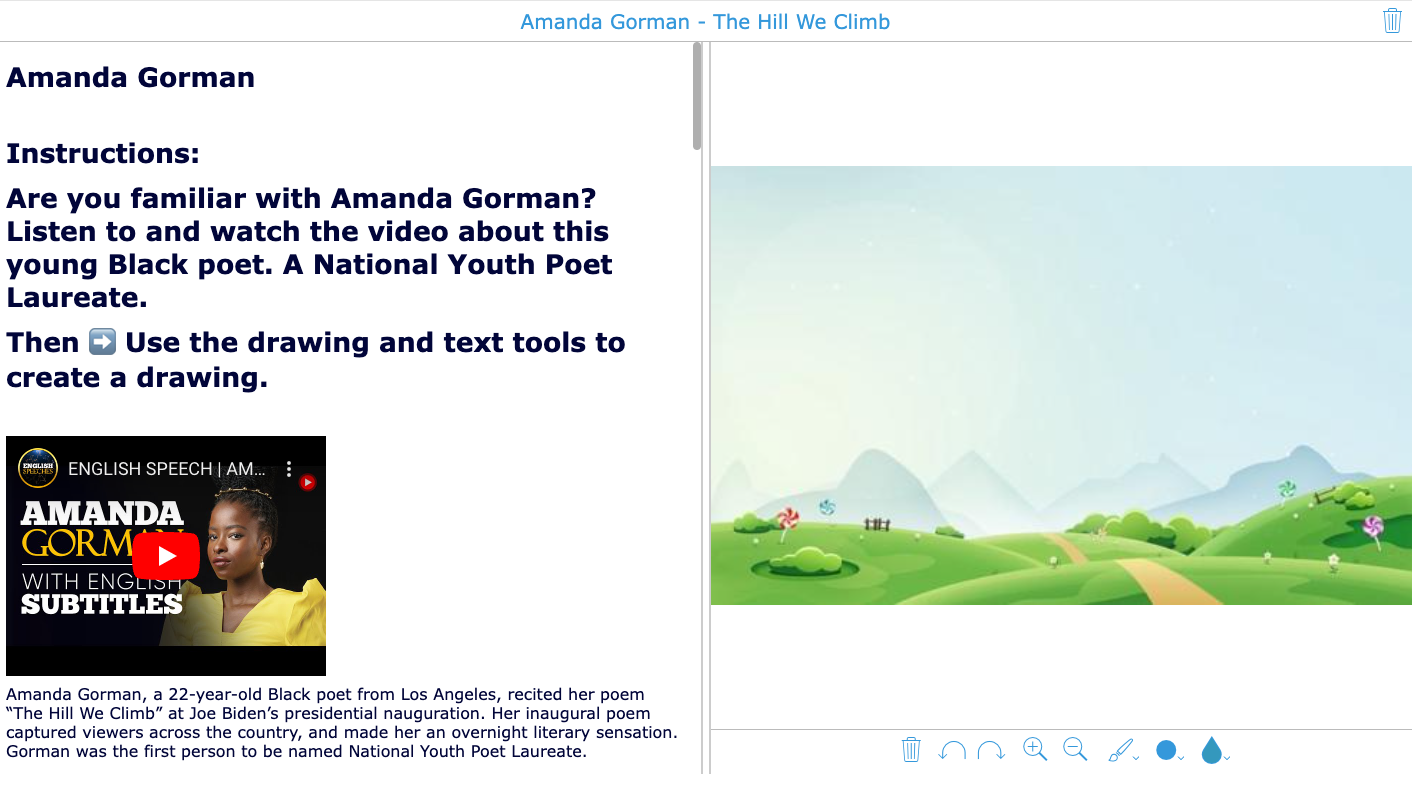
Click to open 💡 Pro tip: Add a graphic organizer as a background image so that students can visually represent their interpretation into a comic strip or storyboard. As in this example featuring Alexander Pope’s Sound and Sense.
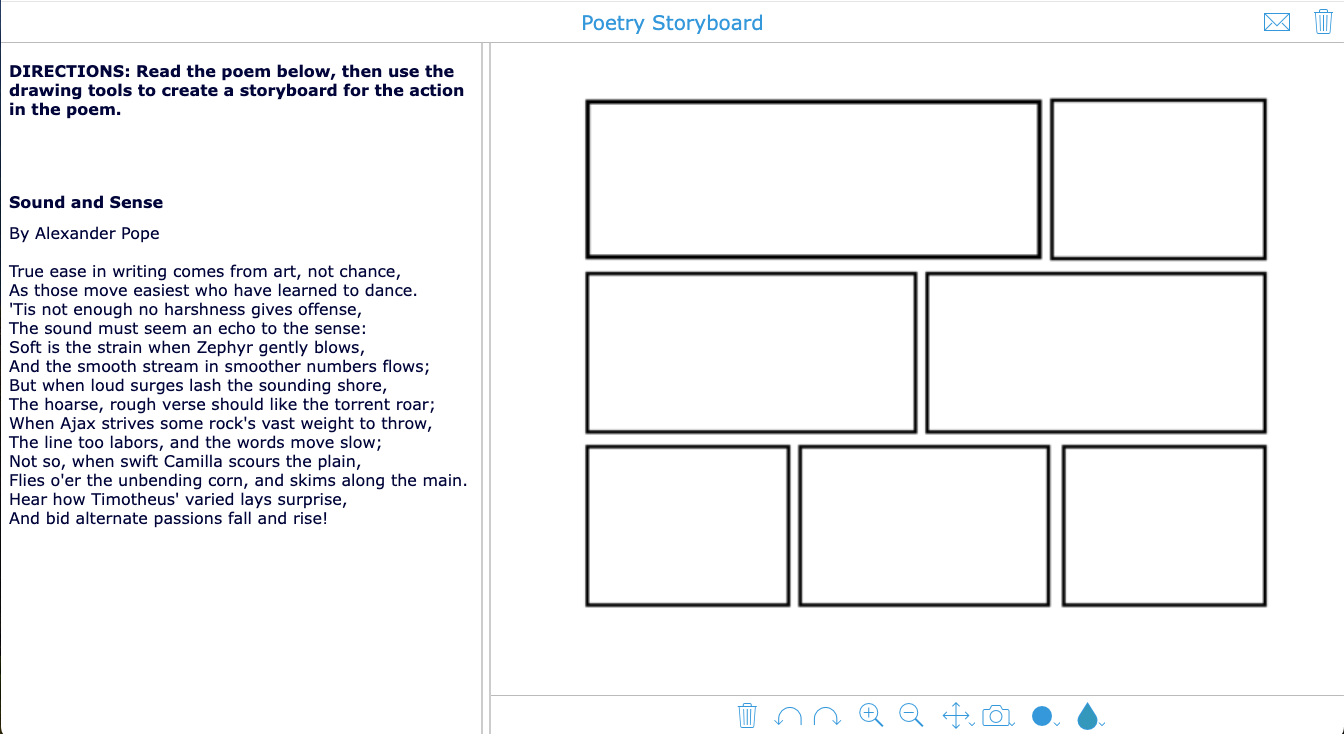
Click to open
10. History & Geography Poetry Integration Activity
Whether you are teaching poetry exclusively or want to infuse poetry exercises in other content areas, this Split Whiteboard widget example activity combines History, Geography, and poetry so that students learn about and trace Sybil Lundington’s ride which was as (& maybe even more!) daring as the famous ride of Paul Revere during the American Revolution.
11. Interactive French Poetry Lesson with Drag & Drop
Poetry in the classroom can be infused into French language instruction in this Split Worksheet widget poetry exercise where students watch and listen to a video recitation of L’Accent then drag and drop the lines of the poem into the correct order.
💡 Pro tip: Looking for other interactive French lessons? Check out this blog post with 10+ Engaging and Ready-To-Use French Lesson Plans for Teachers and Students.
12. Funny Shakespeare: Poetry Flash Card Jokes
Have fun with this Flash Card widget poetry activity that will surely make your students laugh or at least groan when they read each joke.
💡 Pro tip: You can add text, images, and audio to flashcards, as well as hints to help students study. Check out this blog post with 20 ways to use digital flashcards in your classroom.

Teach Poetic Devices with Interactive Lessons
This next collection of interactive poetry activities for middle and high school students introduces poetic forms and literary techniques in a creative, accessible way. Students explore everything from the rhythmic intricacies of traditional sonnets to the expressive freedom of modern verse. These digital poetry lessons for teaching poetic devices incorporate engaging tools like storyboards, whiteboards, and multimedia prompts to emphasize structure, rhyme, and meter. With a special focus on the Imagist movement, learners practice conveying complex ideas through precise, vivid imagery. These poetry annotation and recitation exercises build critical thinking, encourage creativity, and deepen students’ appreciation for the art of poetry.
13. Flash Cards to Teach Poetic Forms
Introduce students to various poetic structures via this Flash Card widget poetry activity. Students can practice memorizing the various types of poems.
💡 Pro tip: You can easily transform Flash Card widget into another widget-type using the import feature. Here I’ve imported the terms and descriptions to a Word Search and Crossword widget activities.
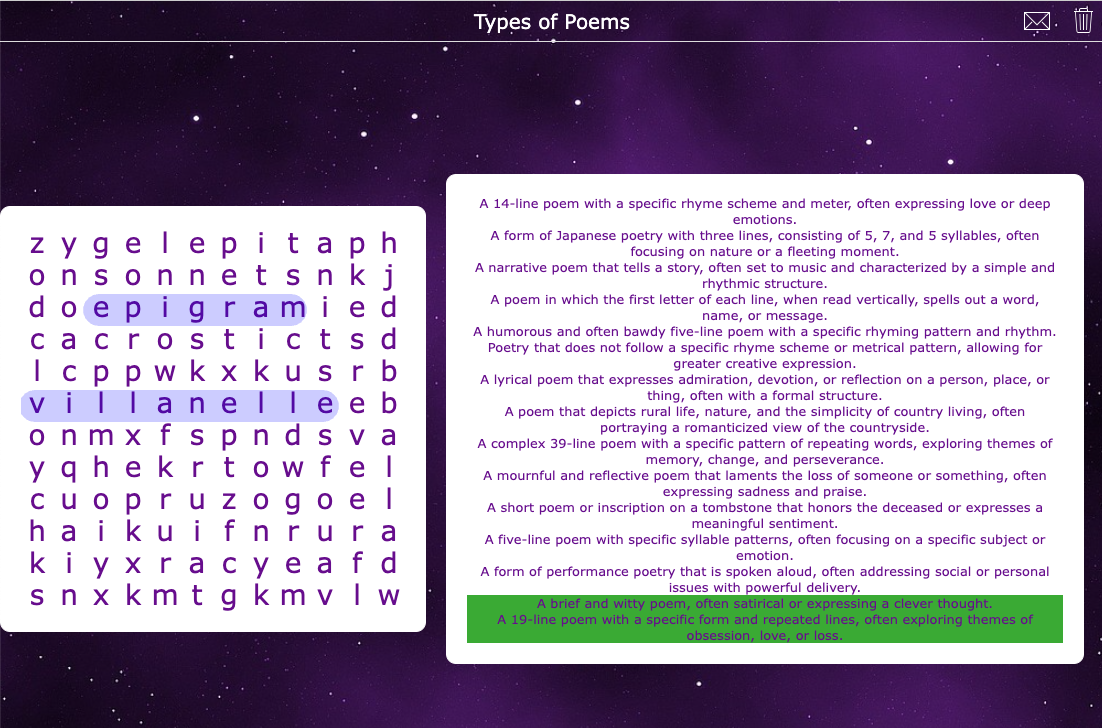
Click to open 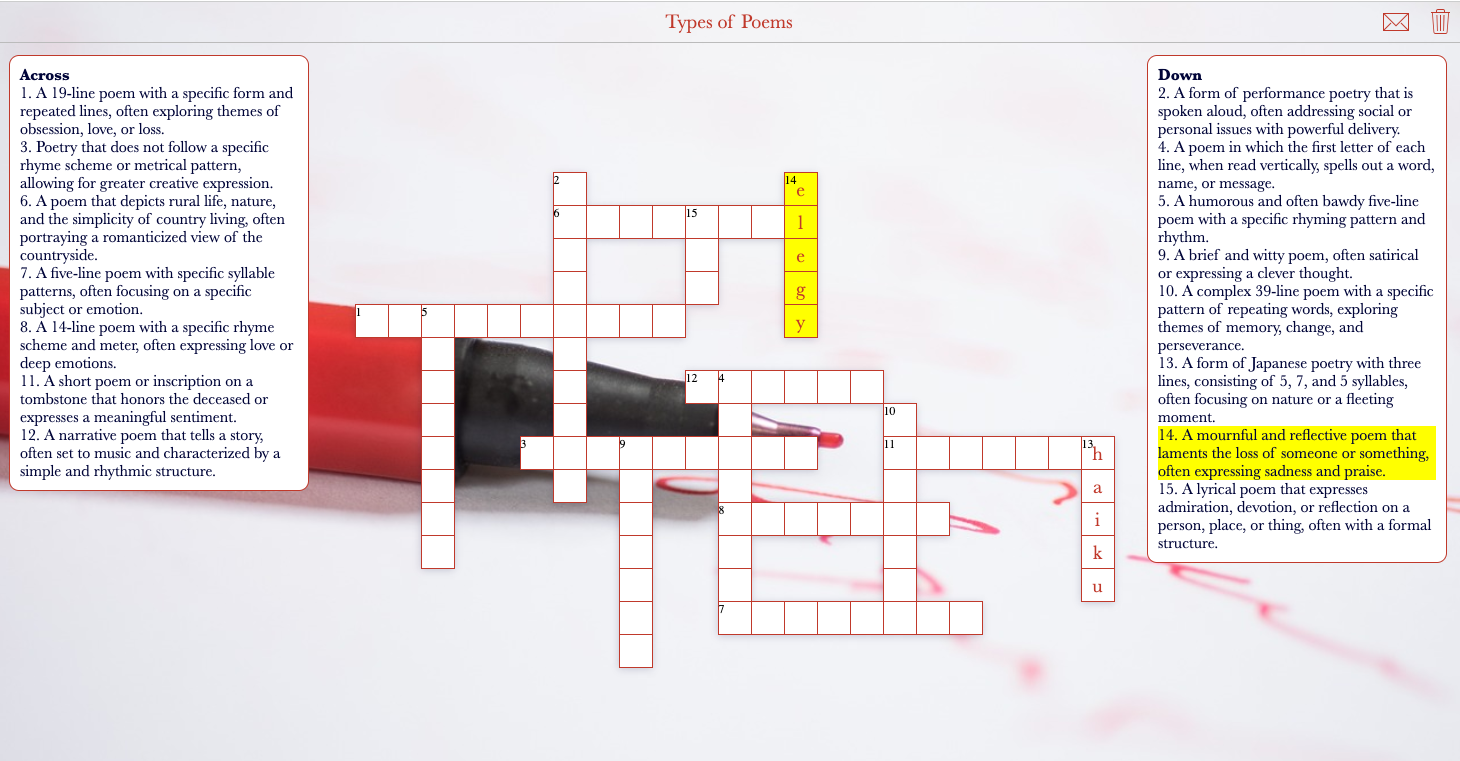
Click to open
14. Assess Poetic Device Knowledge with a Quiz
This classroom poetry exercise made with a Quiz widget can be used for summative or formative assessments to check students’ understanding of poetic terminology such as alliteration, consonance, hyperbole, enjambment, and allusion.
💡 Pro tip: You can also transform a Quiz widget into a Worksheet widget using the import feature. You can duplicate an entire widget or individual questions. The possibilities are endless for differentiated instruction! Check out this blog post for 40 Innovative Ways Teachers Can Digitally Differentiate Their Lessons with BookWidgets.
15. Storyboard and Annotate Poems with Multimedia Worksheets
With a Split Worksheet widget, you can provide a multimedia poetry experience for students by embedding videos, audio, or web pages in one panel and tasking students with answering questions in the other panel. Students can also showcase their creativity for understanding a poem by drafting a storyboard of the poem or practicing their annotation skills in a Whiteboard question.
💡 Pro tip: You can save exemplary student submissions of Whiteboard question as PDFs and share them to your class’ LMS or print them for display in the classroom. This is a great way to recognize their artistry and skill in annotation!
16. French Language Poetry Activity with Audio and Art
This Split Worksheet widget, also provides a multimedia poetry experience for students studying French. Students read information, watch a video, and listen to the audio recitation of the poem before answering the questions and drawing their own “face of happiness” in a culminating Whiteboard question.
17. Identify Rhyme Scheme in Shakespeare’s Sonnets
In this quick Worksheet widget poetry exercise, students practice identifying the rhyme scheme of Sonnet 130 by Shakespeare using the mark sentence question type. This activity could be used as a Do-Now or Exit Ticket, and by having students click the button to reveal answers, they can receive feedback in real time.
💡 Pro tip: Duplicate this widget and swap out Sonnet 130 for another sonnet for students to practice annotating. After repeating this quick activity multiple times, students should be able to easily spot the rhyming pattern. And as an added bonus, you could compile the individual sonnet annotation activities by importing them into a quiz, since all of your questions are banked!
18. Explore Imagist Poetry with Interactive Worksheets
In this Split Worksheet widget poetry activity for middle or high school classes, students explore the Imagist movement by examining three example poems. This activity can serve as a quick introduction to the Modernism and Imagist movements of poetry and the evolution of poetic expression and the breaking away from traditional forms. These movements, emphasizing clarity, precision, and economy of language, alongside innovative imagery and free verse, reflect the broader cultural shifts of the early 20th century. Understanding these movements enriches students’ appreciation of poetry’s diversity and its power to capture complex human experiences and emotions in a rapidly changing world.
💡 Pro tip: In addition to text, images, and videos, teachers can also embed web pages on one side of the Split Worksheet widget.
19. Write Poetry Using Image Prompts
Teachers can harness the power of imagery to inspire all students in their poetry writing–no matter the structure, whether it be a haiku, free verse, or sonnet–using the Random Images widget. By providing vivid, thought-provoking images, educators can stimulate students’ imaginations and encourage them to explore their thoughts and feelings through verse and poetic techniques learned in the other interactive poetry activities. This approach not only aids in the development of creative expression, but also enhances observational skills and emotional literacy, providing a rich foundation for students to craft their unique poetic voices.
💡 Pro tip: No need to scour the world wide web! Use the Pixabay integration to locate images for inspiration.
20. Write Haikus with Visual Inspiration
Haikus may seem easy to write with their three lines of 5-7-5 syllables, but don’t be fooled by their conciseness. This traditional form of Japanese poetry demands precision and economy, challenging poets to convey depth, emotion, and often an observation of nature within a tight framework. The artistry lies in the subtle interplay of imagery and juxtaposition, inviting readers to uncover layers of meaning in just a few lines. Inspire students to compose haikus using this Random Images widget.
💡 Pro tip: Open this widget on a smart board for a whole class activity or share this widget via a QR code to create an engaging poetry station activity that gets students up and moving about the room.
21. Poetry Timeline Research Project
This quick, digital poetry research project, made with a Timeline widget, tasks students with selecting a topic that has consistently inspired poets and reflects universal human experiences and emotions. After students select their topic, they are tasked with finding poems from various cultures and historical time periods and compose a short paragraph for each, explaining how the poem addresses the topic as they add text and images to each box on the timeline. This activity can be used as part of the brainstorming phase for writing a more extensive poetry explication essay.
💡 Pro tip: Use this Checklist widget to provide a roadmap for students to follow in writing a poetry explication essay.
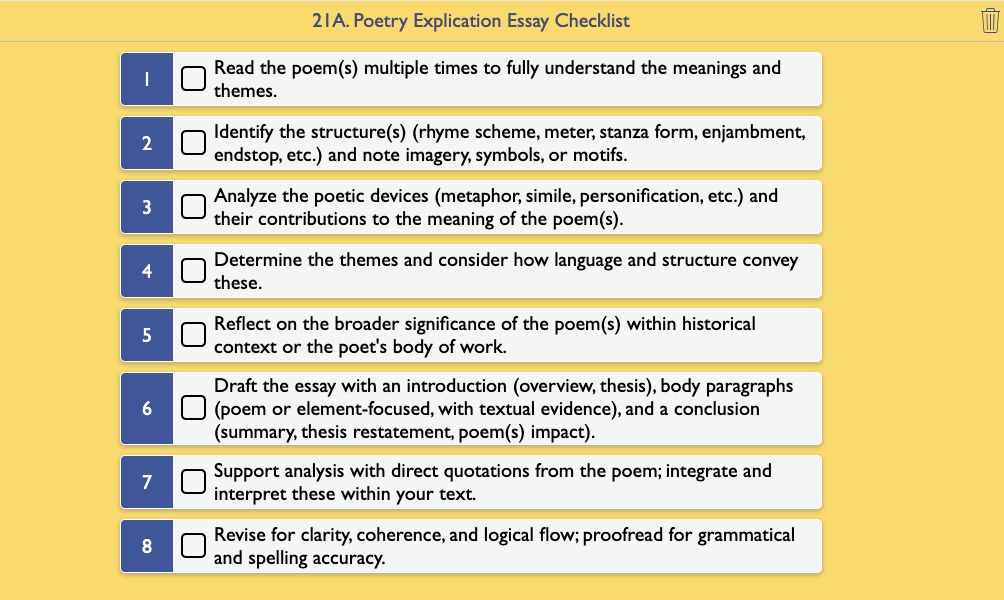
Click to open

Advanced Poetry Lessons for Creative Expression
This final collection of advanced poetry lessons for high school students blends engagement, creativity, and mastery of poetic techniques. Learners dive deeper into teaching poetry movements and poetic meter through interactive activities, explore the structure of Shakespearean sonnets, and practice higher-order thinking with digital poetry annotation exercises. These free poetry lesson plans for National Poetry Month and beyond empower students to compose original poems with confidence while deepening their understanding of literary craft.
22. Research Poetry Movements with a Mind Map
This digital poetry exercise enhances listening, speaking, and research skills, suitable for various settings including whole class, groups, or pairs. When exploring influential poetry movements such as Romanticism and the Harlem Renaissance, students can use a digital Mind Map widget activity to systematically organize and present their research. In a lecture-based approach, students add notes from the teacher’s presentation on each movement to their mindmaps. Alternatively, in a collaborative setting, students are grouped to investigate specific movements, then the groups are reconfigured for sharing and compiling other findings into their individual mindmaps. For even more mindmapping activities, check out this blog post: 15 Powerful Mindmap Lesson Ideas for Teachers to Unlock Creative Teaching.
💡 Pro tip: You could assign a movement to groups using this Randomness spinner! After students are paired up or grouped, have them spin the wheel to reveal which poetry movement they will research.
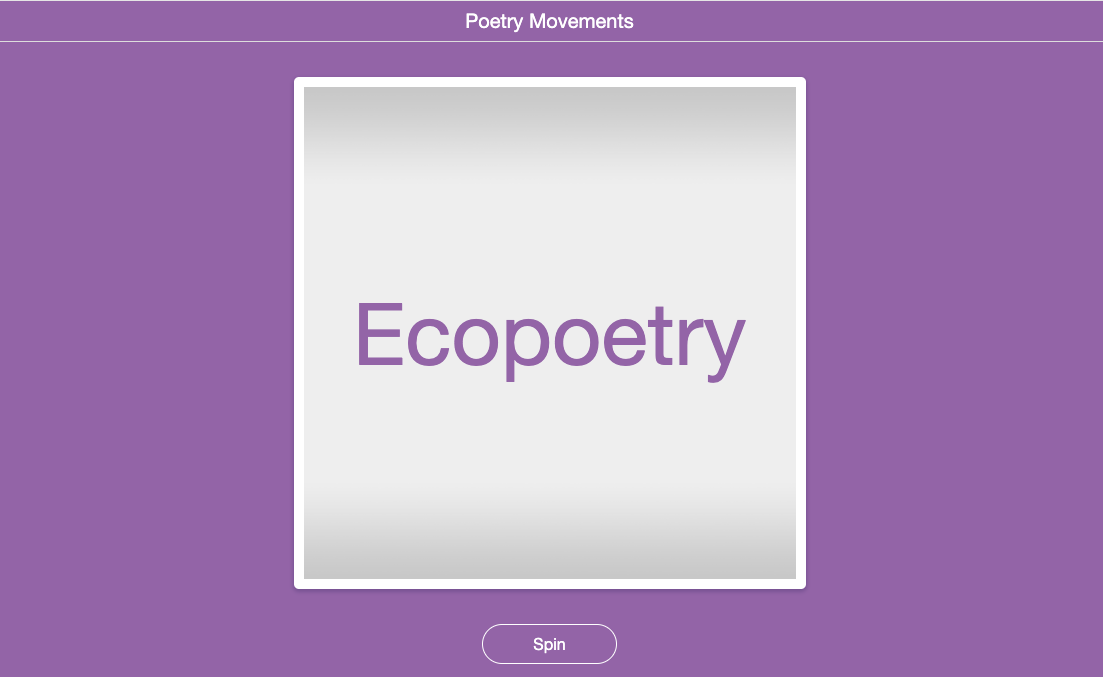
Click to open
23. Learn Poetic Meter with an Interactive Worksheet
In this Split Worksheet widget poetry activity, students are introduced to poetic meter. They read the text on one side of the screen and answer the questions on the other. Understanding poetic meter sets the stage for composing and reciting their own spoken-word poetry.
💡 Pro tip: Students can resize the reading pane by dragging the center line to the left or right to make the text wider or more narrow as needed.
24. Digital Annotation Activity for Poetry Analysis
The Whiteboard widget is an ideal tool to use for poetry annotation practice. Simply capture a screenshot of the text of a poem and use it as a background image on the canvas. Students can use the tools to mark up the meter, rhyme scheme, poetic term examples, and more! Check out this example featuring Alexander Pope’s poem, Sound and Sense.
💡 Pro tip: In the General settings of the widget editor, select “Allow Download” enabling students to download their submission as PDF and/or PNG for offline and app-smashing access. After saving their annotations as a PNG, students can upload the PNG into a Word or Google doc when writing a poetry explication essay or they could add the images to other online creative tools they may be using in the classroom. Check out this blog post, The Student as Content Creator- 15 Content Creation Apps for in the Classroom, for ideas!
25. Blended Learning Video Poetry Lesson for Annotation
For a blended learning experience combining digital tools and paper, use a document camera to record yourself annotating a poem on a page then upload that recording to YouTube and embed the video in a Quiz, Worksheet, or Video Quiz widget. Here is an example I made using a Quiz widget for annotating the Prologue to Shakespeare’s Romeo and Juliet. Students follow along with the video, pausing and rewinding as needed, to annotate their paper copy. How do I know they watched my video? Well, I include a Photo question for students to upload an image of their annotated paper and ask some additional auto-scored questions to check their understanding.
💡 Pro tip: Interested in creating your own explainer videos? These blog posts, The 5 Most Important Questions about Flipping the Classroom with Edtech, and How Your Video Lessons Can Be Even More Successful When You’re on Screen, provide plenty of tips and tricks for recording and incorporating video into your instructional practices.
26. TED-Ed Video Quiz: Shakespeare and Iambic Pentameter
In this Video Quiz made with a video from TED-Ed, students answer the age-old question, “Why did Shakespeare write in iambic pentameter?” In addition to checking their understanding of the content in the video, this digital poetry lesson culminates with a whiteboard question where students use the drawing tools to practice annotating one of Shakespeare’s sonnets.
27. Video Lesson: Writing Your Own Shakespearean Sonnet
In this Video Quiz, students can learn about the structure of Shakespeare’s sonnets and practice composing their own.
28. Spoken Word Poetry Lesson with Slam Inspiration
This Video Quiz features the artistry of Pages Matam, a National Poetry Slam champion originally from Cameroon, Central Africa. Matam’s Tedx Talk featured can inspire students to find their voice and communicate their passion, and serve as an introduction to Poetry Slams, a competition where poets compete in spoken word performances before a live audience and a panel of judges. Interested in more examples of Slam Poetry? Check out 25 Slam Poetry Examples to Inspire Students of All Ages by *We Are Teachers.*
💡 Pro tip: Incorporating Audio Response questions inside of Video Quizzes allows students to see and practice doing the techniques being modeled in the video. You can then do a live poetry slam or a digital one using tools like Microsoft’s Flip.
29. Random Poetry Writing Challenge
Use this Randomness widget activity for a dizzying and quick fire poetry writing session. Students spin the wheel to reveal a poetic structure and topic for which they will compose a poem.
💡 Pro tip: For an analytical spin, you can ask ChatGPT to generate the poem and have students analyze the quality of the poetry generated by the artificial intelligence. Students could discuss the characteristics of the type of poem and discuss ways in which the poem could be improved. Here is ChatGPT’s DREAMS Acrostic annotation activity made with a Whiteboard widget.
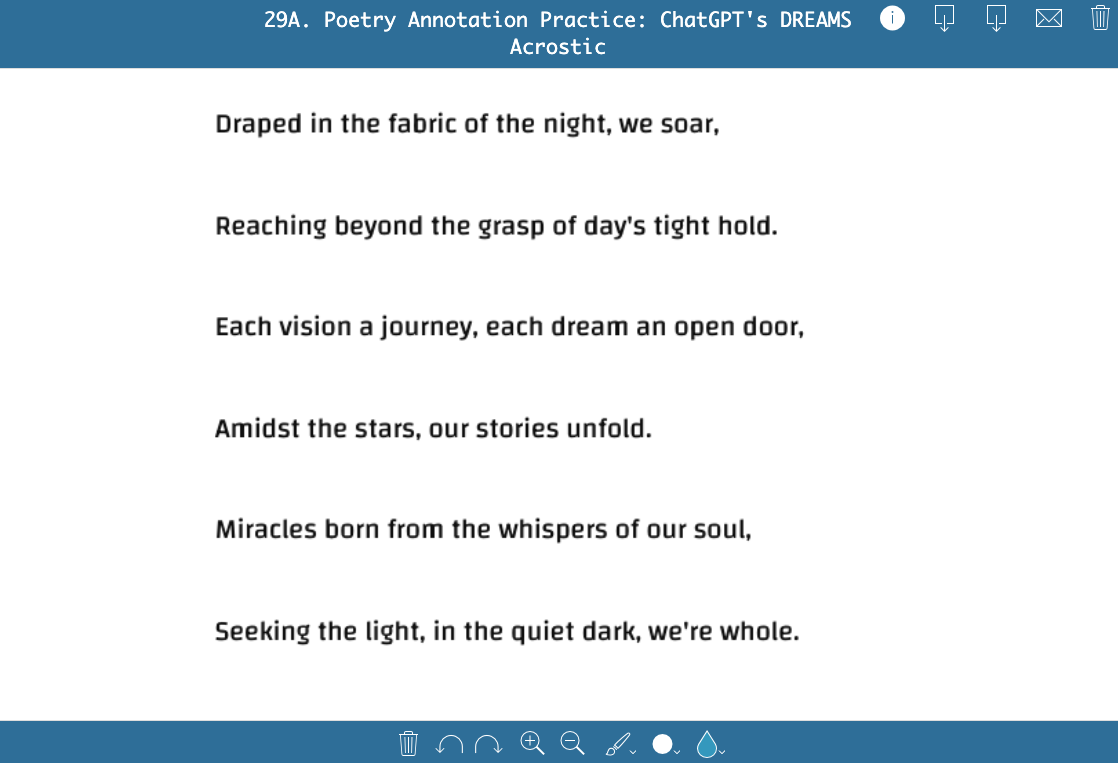
Click to open
30. Ecopoetry Activity with National Park Exploration
Ecopoetry, a compelling branch of contemporary literature, intertwines the poetic voice with an acute awareness of the environment and our place within the natural world. This genre not only celebrates the beauty and majesty of nature, but also confronts the urgent ecological issues of our time, serving as a bridge between human emotion and the landscapes that sustain us. For an in-person ecopoetry experience, have students visit the National Parks in person and check out the poetry installations by Ada Limón, the nation’s 24th Poet Laureate Consultant in Poetry, who in partnership with the Library of Congress and the Poetry Society of America will feature site-specific poetry installations in seven national parks.
But if unable to do a class field trip in person, this last poetry activity inspires students to virtually explore 20 of the 63 National Parks in the United States through an annotated Google Map widget. Students click on the map marker, read the information for each location, view the images, and even visit any linked resources. They can then choose a location as inspiration for a poem writing. Students can also explore each location via Street View with the Google Map widget.
💡 Pro tip: You can also use an Image Carousel widget to group images together for students to explore. Think of this as an image slideshow on steroids! Add text or image hotspots on multiple images that students can click, and map the images to an associated location on Google Maps. Here are three Image Carousel widget I made featuring sites in Acadia National Park, Yosemite National Park, and Yellowstone National Park.

Click to open 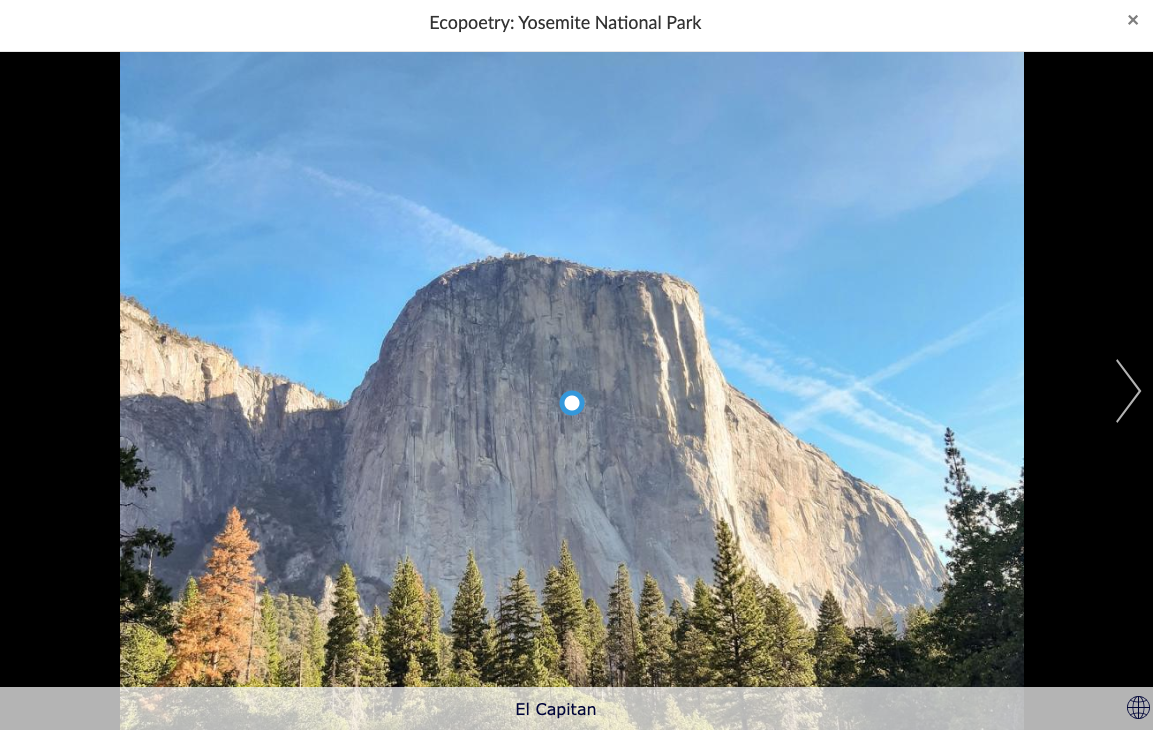
Click to open 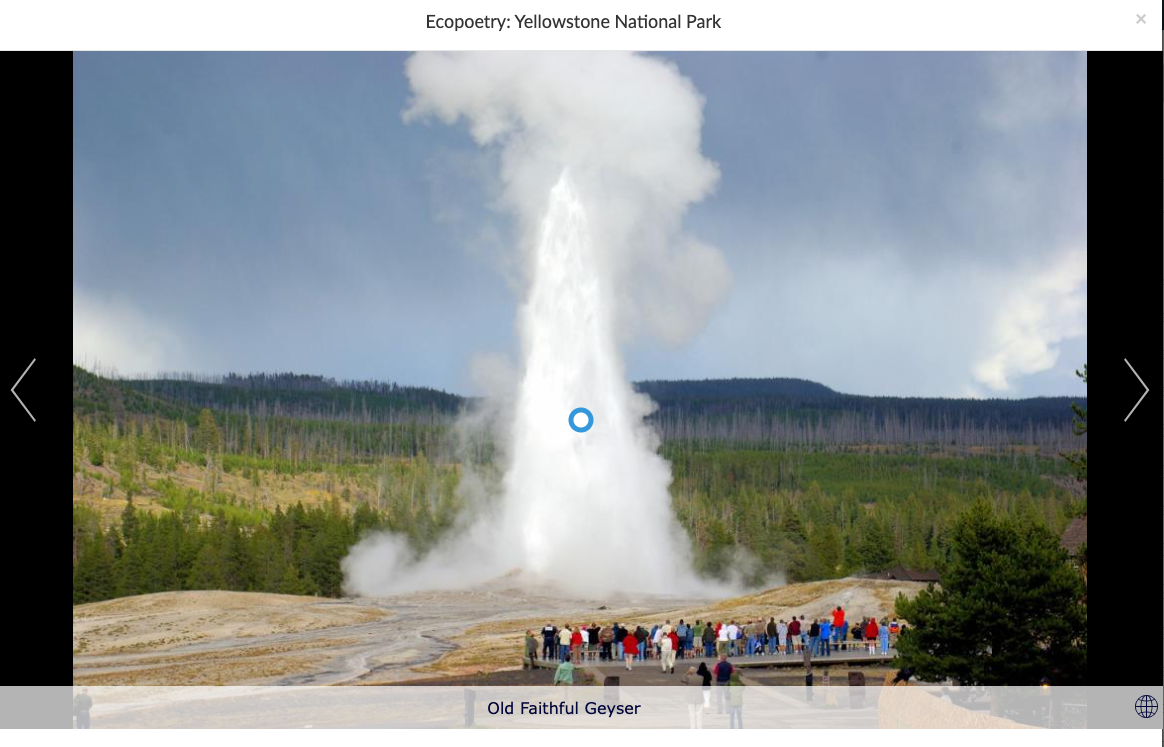
Click to open
Wrap up
This collection of 30+ free, online poetry lessons should serve as inspiration to make poetry engaging and accessible where every click can cultivate a couplet and every screen can spark a sonnet. I invite you to rhyme, revel, and resonate with your students, turning tech into the ultimate muse for tomorrow’s poets. Let every keystroke kindle creativity, as you continue on this journey where pixels paint poems and screens become the canvas for our collective poetic spirit!
Want to learn more about creating engaging lesson activities with BookWidgets?
✔️ Sign up for upcoming free webinars and view recordings on the BookWidgets Teacher Academy Page.
✔️ Learn more about our special, limited-time pricing for groups of teachers for purchasing BookWidgets now without having to wait for the next school year or budget cycle.
✔️ Follow BookWidgets on BlueSky and LinkedIn and join our teacher community on Facebook!
✔️ And, be sure to connect with me, too, on BlueSky, Facebook, and LinkedIn!
